ARRIS TG2472 Touchstone Wireless Telephony Gateway User Manual TG2472G NA Telephony Gateway User Guide
ARRIS Group, Inc. Touchstone Wireless Telephony Gateway TG2472G NA Telephony Gateway User Guide
ARRIS >
Users Manual
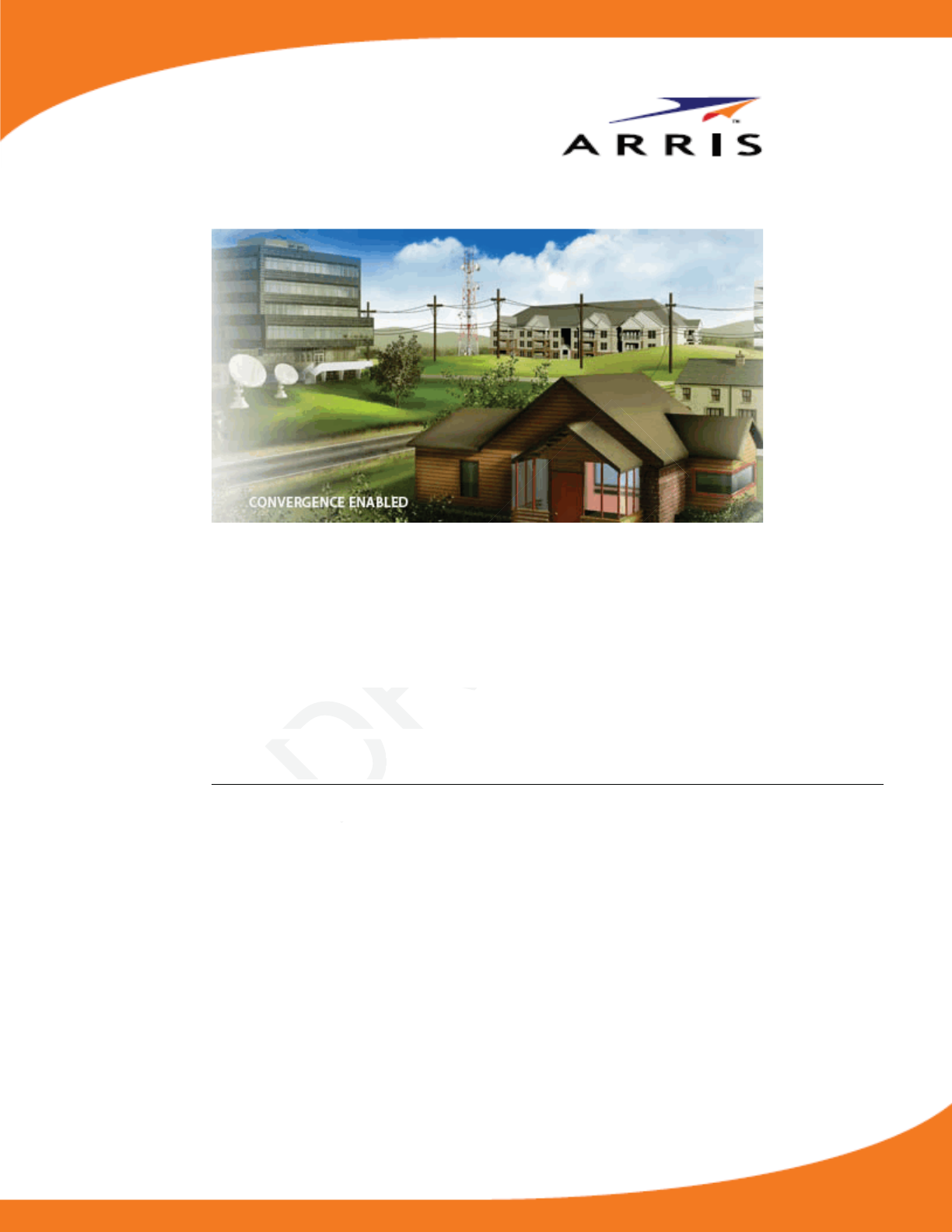
Touchstone TG2472 Telephony
Gateway
User Guide
Release 24 DRAFT 1.0 November 2014
DRAFT
uchstone Tuchstone T
teway
teway
D

Touchstone TG2472 Telephony Gateway User Guide
Release 24 DRAFT 1.0
ARRIS Copyrights and Trademarks
©ARRIS Enterprises, Inc. 2014 All rights reserved. No part of this publication may be reproduced
in any form or by any means or used to make any derivative work (such as translation,
transformation, or adaptation) without written permission from ARRIS Enterprises, Inc.
(“ARRIS”). ARRIS reserves the right to revise this publication and to make changes in content
from time to time without obligation on the part of ARRIS to provide notification of such revision
or change.
ARRIS and the ARRIS logo are all trademarks of ARRIS Enterprises, Inc. Other trademarks and
trade names may be used in this document to refer to either the entities claiming the marks and the
names of their products. ARRIS disclaims proprietary interest in the marks and names of others.
ARRIS provides this guide without warranty of any kind, implied or expressed, including, but not
limited to, the implied warranties of merchantability and fitness for a particular purpose. ARRIS
may make improvements or changes in the product(s) described in this manual at any time.
The capabilities, system requirements and/or compatibility with third-party products described
herein are subject to change without notice.
Patent Notice
Protected under one or more of the following U.S. patents: http://www.arrisi.com/legal
Other patents pending.
DRAFT
e ee e
est in theest in
d, implied or expr
d, implied
y and fitness for a partic
y and fitness for
uct(s) described in this ma
uct(s) described in this
r compatibility with thirdcompatibility with third
e.
re of the following U.S. pare of the following U

Table of Contents
Chapter 1. Overview.............................................................................. 5
Introduction (Overview) .................................................................................. 5
Chapter 2. Safety Requirements ............................................................... 7
FCC Part 15 ................................................................................................. 8
RF Exposure .......................................................................................... 8
Industry Canada Compliance............................................................................. 9
For Mexico................................................................................................... 9
European Compliance ..................................................................................... 9
Chapter 3. Getting Started .....................................................................10
About Your New Telephony Gateway................................................................. 10
What's in the Box......................................................................................... 10
Items You Need........................................................................................... 10
Getting Service ........................................................................................... 12
System Requirements ................................................................................... 12
Recommended Hardware ........................................................................ 12
Windows ............................................................................................ 12
MacOS ............................................................................................... 12
Linux/other Unix .................................................................................. 13
About this Manual........................................................................................ 13
What about Security..................................................................................... 13
Ethernet or Wireless?.................................................................................... 14
Chapter 4. Battery Installation and Removal ...............................................16
Introduction (Battery Installation and Removal) ................................................... 16
Basic Battery Installation and Replacement ........................................................ 17
Extended Battery Installation and Replacement ................................................... 18
Chapter 5. Installing and Connecting your Telephony Gateway ........................21
Front Panel................................................................................................ 22
Rear Panel................................................................................................. 23
Selecting an Installation Location..................................................................... 23
Desktop Mounting Instructions.................................................................. 24
Factors Affecting Wireless Range .............................................................. 24
Connecting the Telephony Gateway.................................................................. 24
Configuring Your Wireless Connection ............................................................... 26
Accessing the Configuration Interface ........................................................ 26
Setting Parental Controls ............................................................................... 26
Finding the MAC Address of a Computer ...................................................... 27
Making Your Parental Control Settings ........................................................ 27
Release 24 DRAFT 1.0 November 2014 Touchstone TG2472 Telephony Gateway User Guide 3
DRAFT
...........
.....................
........................
.............
............................
........................
.............................................
.....................................
................................................
...................................................
.............................................
.................................................
rityrity
.................................................
ireless?ss?
........................................
y Installation and Rey Installation and
uction (Battery Installa
uction (Battery Installa
tery Installation tery Installatio
ttery Instttery Inst

Chapter 6. Configuring Your Ethernet Connection ........................................29
Requirements ............................................................................................. 29
How to use this Chapter ................................................................................ 29
TCP/IP Configuration for Windows XP................................................................ 29
TCP/IP Configuration for Windows Vista............................................................. 30
TCP/IP Configuration for Windows 7 or Windows 8 ................................................ 30
TCP/IP Configuration for MacOS X .................................................................... 31
Chapter 7. Using the Telephony Gateway...................................................32
Setting up Your Computer to Use the Telephony Gateway....................................... 32
Indicator Lights for the TG2472 ....................................................................... 32
Wiring Problems ................................................................................... 33
Patterns: Normal Operation (LAN and Telephone).......................................... 33
Patterns: Normal Operation (WAN and Battery)............................................. 33
Patterns: Startup Sequence ..................................................................... 34
Using the Reset Button........................................................................... 35
Resetting the Router to Factory Defaults .................................................... 36
Booting from Battery ............................................................................. 36
Chapter 8. Troubleshooting ....................................................................37
The Telephony Gateway is plugged in, but the Power light is Off .............................. 37
I'm not getting on the Internet (all connections) .................................................. 37
I'm not getting on the Internet (Ethernet) .......................................................... 37
I'm not getting on the Internet (Wireless) ........................................................... 37
My wireless Internet connection stops working sometimes ...................................... 38
I can get on the Internet, but everything is slow .................................................. 38
I don't have a dial tone when I pick up the phone - why? ........................................ 38
Chapter 9. Glossary ..............................................................................40
Chapter 10. ARRIS Contacts...................................................................... 43
Before You Call ARRIS Support......................................................................... 43
By Telephone ............................................................................................. 43
By Email ................................................................................................... 45
Ask ARRIS Customer Portal ............................................................................. 47
Global Knowledge Services and Training ............................................................ 47
Release 24 DRAFT 1.0 November 2014 Touchstone TG2472 Telephony Gateway User Guide 4
............
.........................
.........................
................
aultsaults
......................
.....
............................................
......................................
ugged in, but the Power ged in, but the Powe
ernet (all connections)ll connections)
Internet (Ethernet)Internet (Etherne
...
the Internet (Wireless)the Internet (Wireless
ernet connection stops wet connection stops w
n the Internet, but everyn the Internet, b
have a dial tone when I phave a dial tone when I
ryry
...........................
actsacts
..
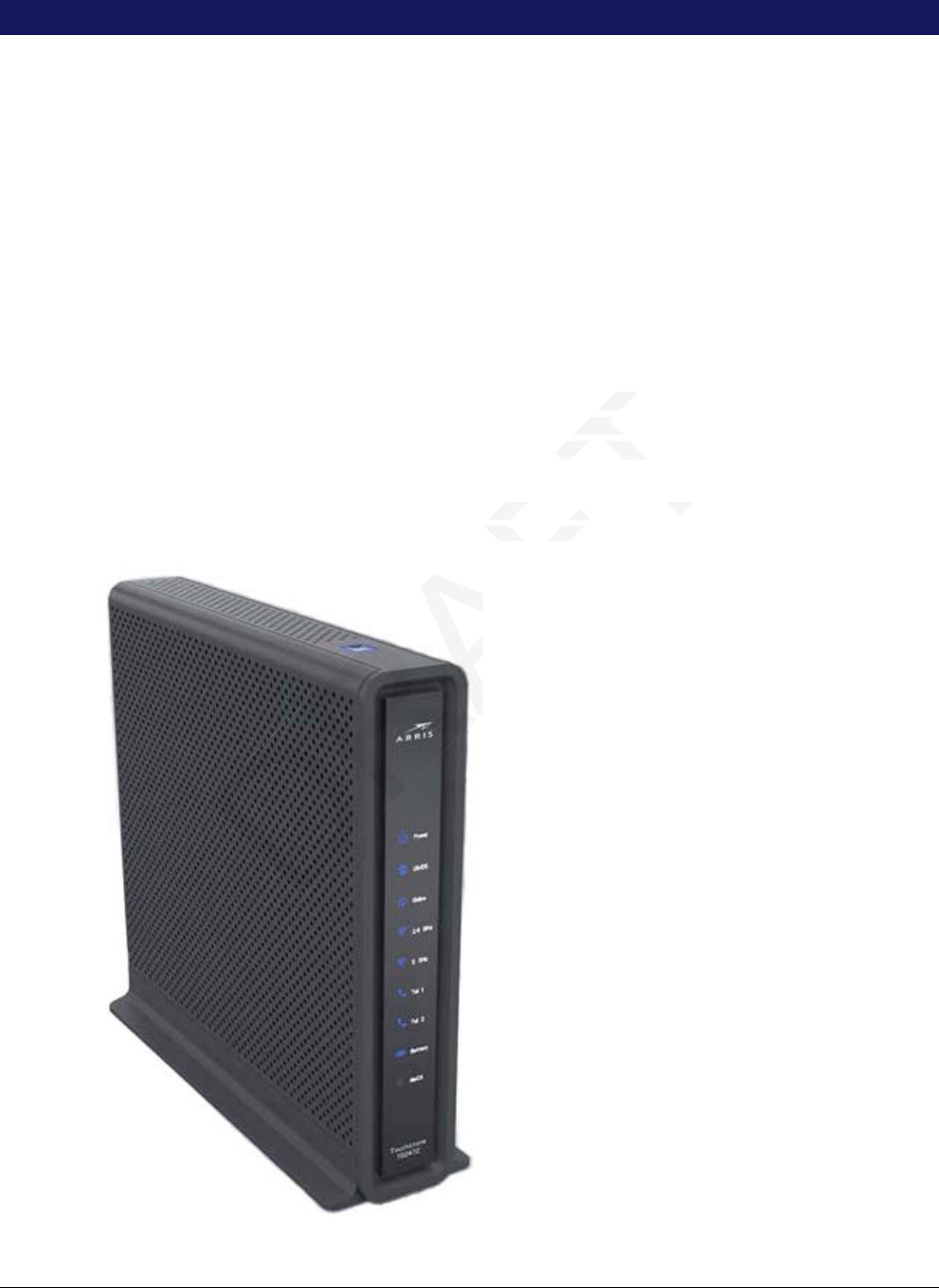
Chapter 1
Overview
Introduction (Overview)
Get ready to experience the Internet’s express lane! Whether you’re checking out streaming media,
downloading new software, checking your email, or talking with friends on the phone, the
Touchstone TG2472 Telephony Gateway brings it all to you faster and more reliably. All while
providing toll quality Voice over IP telephone service and both wired and wireless connectivity. It
also provides a Lithium-Ion battery backup to provide continued telephone service during power
outages.
The Touchstone TG2472 Telephony Gateway provides four Ethernet connections for use as the hub
of your home/office Local Area Network (LAN). The TG2472 also provides 802.11a/b/g/n/ac
wireless connectivity for enhanced mobility and versatility. In addition, the TG2472 provides for up
to two separate lines of telephone service.
The Telephony Gateway also offers integrated MoCA 2.0 home networking providing Internet access
and transfer of multimedia content between devices over coaxial cable in the home.
Release 24 DRAFT 1.0 November 2014 Touchstone TG2472 Telephony Gateway User Guide 5
RAFT
EtherneEther
472 also prov472 al
tility. In addition, th
ility. In add
MoCA 2.MoCA
0 home network
home network
devices over coaxial cablevices over c

Chapter 1: Overview
Installation is simple and your cable company will provide assistance to you for any special
requirements.
Release 24 DRAFT 1.0 November 2014 Touchstone TG2472 Telephony Gateway User Guide 6
DRAFT

Chapter 2
Safety Requirements
The ARRIS Telephony Gateway complies with the applicable requirements for performance,
construction, labeling, and information when used as outlined below:
CAUTION
Potential equipment damage
Potential loss of service
Connecting the Telephony Gateway to existing telephone wiring should only be performed by a
professional installer. Physical connections to the previous telephone provider must be removed and
the wiring must be checked; there must not be any voltages. Cancelation of telephone service is not
adequate. Failure to do so may result in loss of service and/or permanent damage to the Telephony
Gateway.
CAUTION
Risk of shock
Mains voltages inside this unit. No user serviceable parts inside. Refer service to qualified personnel
only!
CAUTION
Risk of explosion
Replacing the battery with an incorrect type, heating a battery above 75°C, or incinerating a battery,
can cause product failure and a risk of fire or battery explosion. Do not dispose of in fire. Recycle or
dispose of used batteries responsibly and in accordance with local ordinances.
The Telephony Gateway is designed to be connected directly to a telephone.
Connecting the Telephony Gateway to the home’s existing telephone wiring should only be
performed by a professional installer.
Do not use product near water (i.e. wet basement, bathtub, sink or near a swimming pool, etc.),
to avoid risk of electrocution.
Do not use the telephone to report a gas leak in the vicinity of the leak.
The product shall be cleaned using only a damp, lint-free, cloth. No solvents or cleaning agents
shall be used.
Do not use spray cleaners or aerosols on the gateway.
Avoid using and/or connecting the equipment during an electrical storm, to avoid risk of
electrocution.
Do not locate the equipment within 6 feet (1.9 m) of a flame or ignition source (i.e. heat registers,
space heaters, fireplaces, etc.).
Use only power supply and power cord included with the equipment.
Equipment should be installed near the power outlet and should be easily -accessible.
Release 24 DRAFT 1.0 November 2014 Touchstone TG2472 Telephony Gateway User Guide 7
DRAFT
ancanc
or permor per
erviceable parts inside. Rble part
with an incorrect type, heth an incorrect type, he
failure and a risk of fire orailure and a risk of fire or
batteries responsibly and batteries responsibl
phony Gateway is design
phony Gateway is design
the Telephony Gthe Telephony
professionprofession
tntn

Chapter 2: Safety Requirements
The shield of the coaxial cable must be connected to earth (grounded) at the entrance to the
building in accordance with applicable national electrical installation codes. In the U.S., this is
required by NFPA 70 (National Electrical Code) Article 820. In the European Union and in
certain other countries, CATV installation equipotential bonding requirements are specified in
IEC 60728-11, Cable networks for television signals, sound signals and interactive services,
Part 11: Safety. This equipment is intended to be installed in accordance with the requirements
of IEC 60728-11 for safe operation.
If the equipment is to be installed in an area serviced by an IT power line network, as is found in
many areas of Norway, special attention should be given that the installation is in accordance
with IEC 60728-11, in particular Annex B and Figure B.4.
In areas of high surge events or poor grounding situations and areas prone to lightning strikes,
additional surge protection may be required (i.e. PF11VNT3 from American Power Conversion)
on the AC, RF, Ethernet and Phone lines.
When the Telephony Gateway is connected to a local computer through Ethernet cables, the
computer must be properly grounded to the building/residence AC ground network. All plug-in
cards within the computer must be properly installed and grounded to the computer frame per
the manufacturer’s specifications.
Ensure proper ventilation. Position the Telephony Gateway so that air flows freely around it and
the ventilation holes on the unit are not blocked.
Do not mount the Telephony Gateway on surfaces that are sensitive to heat and/or which may be
damaged by the heat generated by the modem, its power supply, or other accessories.
FCC Part 15
This equipment has been tested and found to comply with the requirements for a Class B digital
device under Part 15 of the Federal Communications Commission (FCC) rules. These requirements
are intended to provide reasonable protection against harmful interference in a residential
installation. This equipment generates, uses and can radiate radio frequency energy and, if not
installed and used in accordance with the instructions, may cause harmful interference to radio
communications. However, there is no guarantee that interference will not occur in a particular
installation. If this equipment does cause harmful interference to radio or television reception, which
can be determined by turning the equipment off and on, the user is encouraged to try to correct the
interference by one or more of the following measures:
Reorient or relocate the receiving antenna.
Increase the separation between the equipment and receiver.
Connect the equipment into an outlet on a circuit different from that to which the receiver is
connected.
Consult the dealer or an experienced radio/TV technician for help.
WARNING
Changes or modifications to this equipment not expressly approved by the party responsible for
compliance could void the user’s authority to operate the equipment.
Release 24 DRAFT 1.0 November 2014 Touchstone TG2472 Telephony Gateway User Guide 8
DRAFT
grogro
Gateway so that a
Gateway s
rfaces that are sensitive to
rfaces that are sensitive
dem, its power supply, ordem, its power supply, or
been tested and found toested and found to
t 15 of the Federal Commt 15 of the Federal
o provide reasonable proto provide reasonable pr
This e
This
quipment generatt generat
ed in accordance ed in accordanc
However, thHowever, th
uipmeuipme
This device complies with part 15 of the FCC Rules. Operation is subject to the following two conditions:
(1) This device may not cause harmful interference, and (2) this device must accept any interference received,
including interference that may cause undesired operations.

Chapter 2: Safety Requirements
Release 24 DRAFT 1.0 November 2014 Touchstone TG2472 Telephony Gateway User Guide 9
RF Exposure
This equipment complies with FCC radiation exposure limits set forth for an uncontrolled
environment. This equipment should be installed and operated with minimum distance of 7.9 inches
(20cm) between the radiator and your body. This transmitter must not be co-located or operating in
conjunction with any other antenna or transmitter.
Industry Canada Compliance
Under Industry Canada regulations, this radio transmitter may only operate using an antenna of a
type and maximum (or lesser) gain approved for the transmitter by Industry Canada. To reduce
potential radio interference to other users, the antenna type and its gain should be so chosen that the
equivalent isotropically radiated power (e.i.r.p.) is not more than that necessary for successful
communication.
This device complies with Industry Canada license-exempt RSS standard(s). Operation is subject to
the following two conditions: (1) this device may not cause interference, and (2) this device must
accept any interference, including interference that may cause undesired operation of the device.
This equipment complies with IC RSS-102 radiation exposure limit set forth for an uncontrolled environment.
This equipment should be installed and operated with minimum distance 20cm between the radiator and your
body.
Conformément à la réglementation d'Industrie Canada, le présent émetteur radio peut fonctionner avec une
antenne d'un type et d'un gain maximal (ou inférieur) approuvé pour l'émetteur par Industrie Canada. Dans le but
de réduire les risques de brouillage radioélectrique à l'intention des autres utilisateurs, il faut choisir le
type d'antenne et son gain de sorte que la puissance isotrope rayonnée équivalente (p.i.r.e.) ne dépasse
pas l'intensité nécessaire à l'établissement d'une communication satisfaisante.
Le présent appareil est conforme aux CNR d'Industrie Canada applicables aux appareils radio exempts de licence.
L'exploitation est autorisée aux deux conditions suivantes : (1) l'appareil nedoit pas produire de brouillage, et
(2) l'utilisateur de l'appareil doit accepter tout brouillage radioélectrique subi, même si le brouillage est
susceptible d'en compromettre le fonctionnement."
Déclaration d’exposition à la radiation : Cet équipement respecte les limites d’exposition aux rayonnements
IC définies pour un environnement non contrôlé. Cet équipement doit être installé et mis en marche à une distance
minimale de 20 cm qui sépare l’élément rayonnant de votre corps.L’émetteur ne doit ni être utilisé avec une autre
antenne ou un autre émetteur ni se trouver à leur proximité.
For Mexico
The operation of this equipment is subject to the following two conditions: (1) This equipment or
device cannot cause harmful interference and (2) this equipment or device must accept any
interference, including interference that may cause some unwanted operation of the equipment.
European Compliance
This product complies with the provisions of the Electromagnetic Compatibility (EMC) Directive
(89/336/EEC), the Amending Directive (92/31/EEC), the Low Voltage Directive (73/23/EEC), and
the CE Marking Directive (93/68/EEC). As such, this product bears the CE marking in accordance
with the above applicable Directive(s).
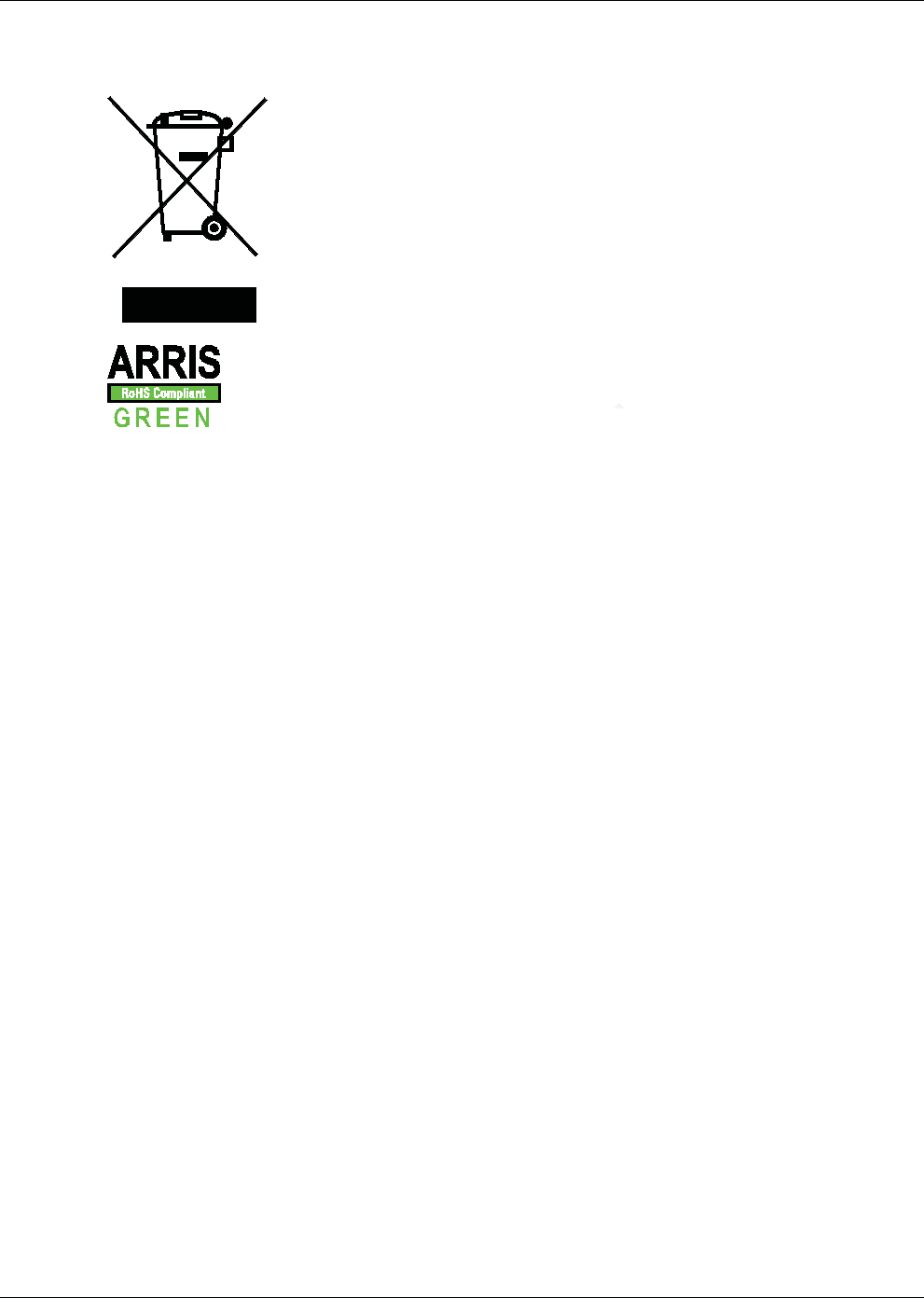
Chapter 2: Safety Requirements
A copy of the Declaration of Conformity may be obtained from: ARRIS International, Inc., 3871
Lakefield Drive, Suite 300, Suwanee, GA 30024.
As indicated by this symbol, disposal of this product or battery is governed by
Directive 2002/96/EC of the European Parliament and of the Council on
waste electrical and electronic equipment (WEEE). WEEE could potentially
prove harmful to the environment; as such, upon disposal of the Telephony
Gateway the Directive requires that this product must not be disposed as
unsorted municipal waste, but rather collected separately and disposed of in
accordance with local WEEE ordinances.
This product complies with directive 2002/95/EC of the European Parliament
and of the Council of 27 January 2003 on the restriction of the use of certain
hazardous substances (RoHS) in electrical and electronic equipment.
Release 24 DRAFT 1.0 November 2014 Touchstone TG2472 Telephony Gateway User Guide
DRAFT
ricric
10

Chapter 3
Getting Started
About Your New Telephony Gateway
The Touchstone TG2472 Telephony Gateway is DOCSIS compliant with the following features:
Speed: much faster than dialup or ISDN service; up to eight times faster than DOCSIS 2.0 cable
modems.
Convenience: supports Ethernet and 802.11a/b/g/n/ac wireless connections; both can be used
simultaneously
Flexibility: provides two independent lines of telephone service as well as high speed data
Compatibility:
x Data services: DOCSIS 3.0 compliant and backward-compatible with DOCSIS 2.0 or 1.1;
supports tiered data services (if offered by your cable -company)
x Telephony services:PacketCable™ 2.0 compliant
The TG2472 provides:
Wireless 802.11a/b/g/n/ac connectivity
Four Ethernet ports for connections to non-wireless devices
Up to two lines of telephone service
Integrated MoCA 2.0 home networking
DOCSIS 3.0 compliant with Li-Ion backup battery
One USB host port (future support for external USB devices)
What's in the Box
Make sure you have the following items before proceeding. Call your cable company for assistance if
anything is missing.
Telephony Gateway
Power Cord
Battery (not included with all models)
Wireless Connection Configuration Guide
Ethernet Cable
End User License Agreement
Items You Need
If you are installing the Telephony Gateway yourself, make sure you have the following items on
hand before continuing:
Release 24 DRAFT 1.0 November 2014 Touchstone TG2472 Telephony Gateway User Guide 11
DRAFT
sese
rvicervi
ackwardackwa
-
compatible wi
ompat
y your cable y you
-
c
ompany)
mpan
compliantcompliant
ctivityctivity
ections to nons to non
--
wireless dewireless de
one serviceone servi
0 home networking0 home netwo
mpliant with Lint with Li
-
Ion backuIon backu
ost port (futureost port (future
support fo supp
he follhe foll
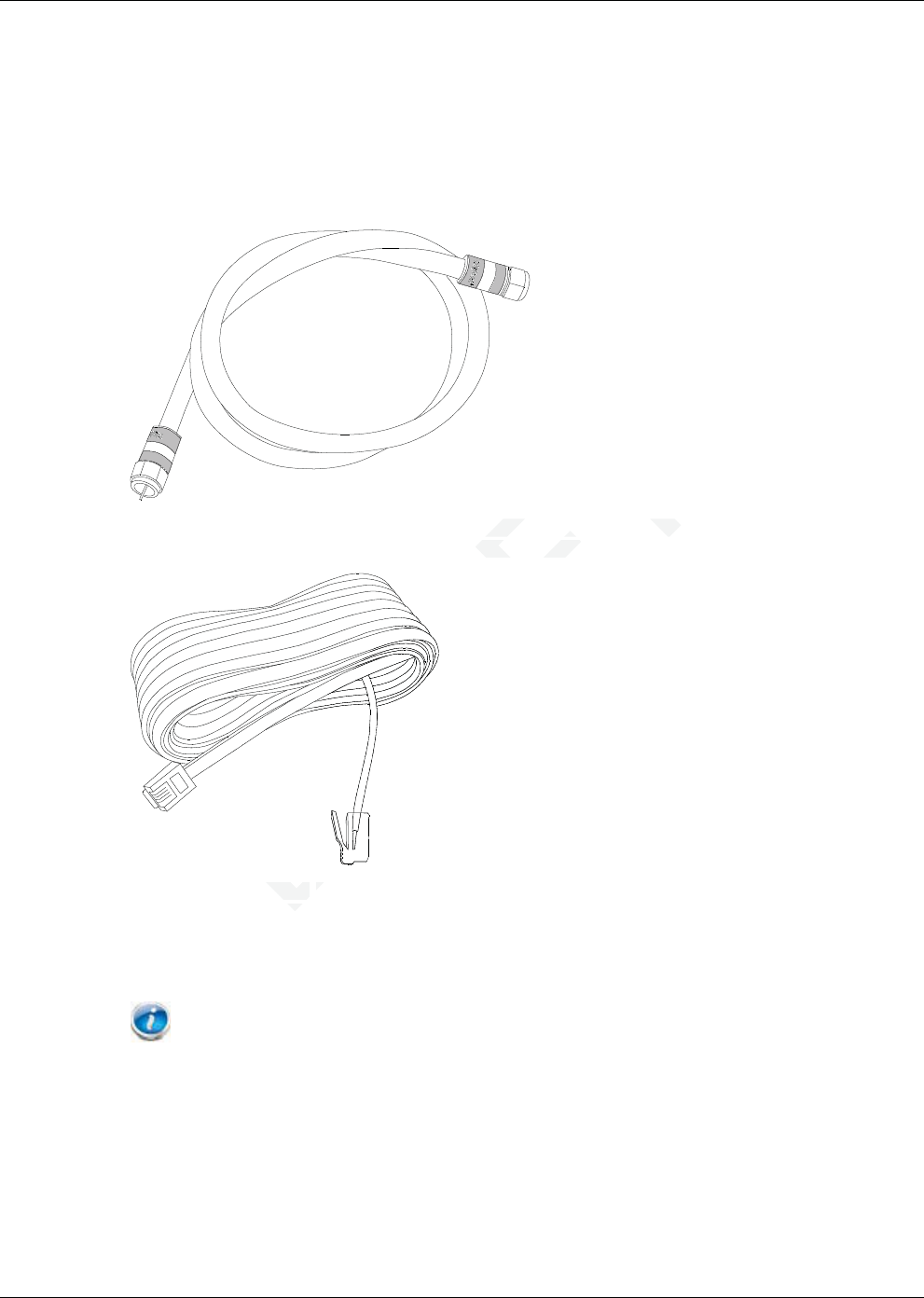
Chapter 3: Getting Started
Telephony Gateway package: see What’s in the Box? (page 10) for a list of items in the
package.
Coaxial cable (coax): This is a round cable with a connector on each end. It is the same kind
of wire used to connect to your television for cable TV. You can buy coax from any electronics
retailer and many discount stores; make sure it has connectors on both ends. There are two types
of connectors, slip-on and screw-on; the screw-on connectors are best for use with your
Telephony Gateway. The coax should be long enough to reach from your Telephony Gateway to
the nearest cable outlet.
Phone Cable: This is a standard phone cable with standard phone connectors (RJ11 type) on
both ends. You can buy phone cables from any electronics retailer and many discount stores.
Splitter (optional): provides an extra cable connection by splitting a single outlet into two.
You may need a splitter if you have a TV already connected to the cable outlet that you want to
use. You can buy a splitter from any electronics retailer and most discount stores; you may also
need a short piece of coax cable (with connectors); use it to connect the splitter to the cable
outlet and then connect the Telephony Gateway and TV to the splitter.
Note: A splitter effectively cuts the signal in half and sends each half to its two outputs.
Using several splitters in a line may deteriorate the quality of your television, telephone, and/or
internet connection.
Information packet: your cable company should furnish you with a packet containing
information about your service and how to set it up. Read this information carefully and contact
your cable company if you have any questions.
Release 24 DRAFT 1.0 November 2014 Touchstone TG2472 Telephony Gateway User Guide 12
DRAFT
RAFT
ble with standard phone
ble with standard phone
m any elem any
ctronics retailerctron
nal):nal):
pp
littlitt
DR
DR
D
DR
DR
DR
DR
DR
DR
DR
DR
DR
DR
D
D
D
D
D
D
D
D
D
D
D
D
D
D
D
D
D
D
D
D
D
D
D
D
D
D
D
D
D
D
D
D
D
DR
D
DR
DR
DR
D
D
D
D
D
D
D
D
D
D
D
D
D
D
D
D
D
D
D
D
D
D
D
D
D
R
R
R
R
R
R
R
R
R
R
R
R
R
R
R
R
R
R
R
R
R
R
R
DR
DR
DR
DR
DR
DR
DR
DR
DR
DR
DR
DR
DR
DR
DR
DR
DR
DR
DR
DR
DR
D
D
D
D
D
D
D
D
D
DR
DR
DR
DR
DR
DR
DR
DR
DR
DR
DR
DR
DR
DR
DR
DR
DR
DR
DR
DR
DR
DR
DR
DR
DR
DR
DR
DR
DR
R
R
R
R
R
R
R
R
R
R
R
R
R
R
R
R
R
R
R
R
R
R
R
D
D
D
R
R
R
R
R
R
R
R
R
R
R
R
RA
RA
RA
RA
RA
RA
RA
RA
RA
RA
RA
RA
RA
RA
RA
RA
RA
R
R
R
R
R
R
R
R
RA
RA
RA
RA
RA
R
R
R
R
R
R
R
R
R
R
R
R
R
R
R
R
R
R
R
R
R
R
R
R
R
R
R
R
R
R
R
R
R
R
R
R
R
R
R
R
R
R
R
R
R
R
R
R
R
R
R
R
R
R
R
RA
RA
RA
RA
RA
RA
RA
RA
RA
RA
RA
RA
RA
RA
RA
RA
RA
RA
RA
RA
RA
RA
RA
RA
RA
RA
RA
RA
RA
RA
RA
RA
RA
RA
RA
RA
RA
RA
RA
RA
RA
RA
RA
RA
RA
RA
RA
RA
RA
RA
R
R
R
R
R
R
R
R
R
R
R
R
R
RA
RA
RA
RA
RA
RA
RA
RA
RA
RA
RA
RA
RA
RA
RA
RA
RA
RA
RA
RA
RA
RA
RA
RA
RA
RA
RA
RA
RA
RA
RA
RA
RA
RA
RA
RA
RA
RA
RA
RA
RA
RA
RA
R
R
R
R
R
R
R
R
R
R
R
R
R
R
R
R
R
R
R
R
R
R
R
R
R
R
RA
RA
RA
RA
RA
RA
RA
RA
RA
RA
RA
RA
RA
RA
RA
RA
RA
RA
RA
RA
RA
RA
RA
RA
RA
RA
RA
RA
RA
R
R
R
R
RA
RA
RA
RA
RA
RA
RA
RA
RA
RA
RA
RA
RA
RA
RA
RA
RA
RA
R
R
R
R
R
RA
RA
RA
RA
RA
RA
RA
RA
RA
RA
RA
RA
R
R
R
R
R
R
R
R
R
R
R
R
R
R
R
R
R
R
R
R
R
R
RA
RA
RA
RA
RA
RA
RA
RA
RA
RA
RA
RA
RA
RA
RA
RA
RA
RA
RA
RA
RA
RA
RA
RA
RA
RA
RA
R
R
RA
RA
RA
RA
RA
RA
A
A
A
A
A
A
A
RA
RA
RA
RA
RA
RA
RA
RA
RA
RA
RA
RA
RA
RA
RA
RA
RA
RA
RA
RA
RA
RA
RA
RA
RA
RA
RA
RA
RA
RA
RA
RA
RA
RA
RA
RA
RA
RA
RA
RA
A
A
A
A
A
A
A
A
A
A
A
A
A
A
A
A
A
RA
RA
RA
RA
RA
RA
RA
RA
RA
RA
RA
RA
RA
RA
RA
RA
RA
RA
RA
RA
RA
RA
RA
RA
RA
RA
RA
RA
RA
RA
RA
RA
RA
RA
R
R
R
A
A
A
A
A
A
A
A
A
A
A
A
A
A
A
A
A
A
A
A
A
RA
RA
RA
RA
RA
RA
RA
RA
RA
RA
RA
RA
RA
RA
RA
RA
RA
RA
RA
R
R
RA
RA
RA
RA
RA
A
A
A
A
A
A
A
A
A
A
A
A
A
A
A
A
A
RA
RA
RA
RA
RA
RA
RA
RA
RA
RA
RA
RA
RA
RA
RA
RA
RA
A
A
A
A
A
A
A
A
A
A
A
A
A
A
A
A
A
A
A
A
A
A
A
A
A
A
A
A
A
A
A
A
A
A
A
A
A
A
A
A
A
A
A
A
A
A
A
A
A
A
A
A

Chapter 3: Getting Started
Getting Service
Before trying to use your new Telephony Gateway, contact your local cable company to establish an
Internet account and telephone service. When you call, have the following information ready:
the Telephony Gateway serial number and cable MAC addresses of the unit (printed on the
Telephony Gateway)
the model number of the Telephony Gateway (printed on the Telephony Gateway)
If the Telephony Gateway was provided by your cable company, they already have the required
information.
In addition, you should ask your cable company the following questions:
Do you have any special system requirements or files that I need to download after I am
connected?
When can I start using my Telephony Gateway?
Do I need a user ID or password to access the Internet or my e-mail?
Will my phone number(s) change?
What new calling features will I have and how do I use them?
System Requirements
The Touchstone Telephony Gateway operates with most computers. The following describes
requirements for each operating system; see the documentation for your system for details on
enabling and configuring networking.
To use the Telephony Gateway, you need DOCSIS high-speed Internet service from your cable
company. Telephone service requires that the cable company has PacketCable support.
Recommended Hardware
The following hardware configuration is recommended. Computers not meeting this configuration
can still work with the TG2472, but may not be able to make maximum use of TG2472 throughput.
CPU: P4, 3GHz or faster
RAM: 1GB or greater
Hard drive: 7200 RPM or faster
Ethernet: Gig-E (1000BaseT)
Windows
Windows XP , Windows Vista, Windows 7, or Windows 8. A supported Ethernet or wireless LAN
connection must be available.
MacOS
System 7.5 to MacOS 9.2 (Open Transport recommended) or MacOS X. A supported Ethernet or
wireless LAN connection must be available.
Release 24 DRAFT 1.0 November 2014 Touchstone TG2472 Telephony Gateway User Guide 13
DRAFT
t or my et or m
-
m
w do I use them?w do I
y operates with most comperates with most co
system; see the documen see the docume
working. working
teway, you need DOCSIS teway, you need DOCS
ervice requires that the crvice requires that the c
wareware
g hardware configuratig hardware configu
ith the TG2472, bith the TG2472
or fasteror faster
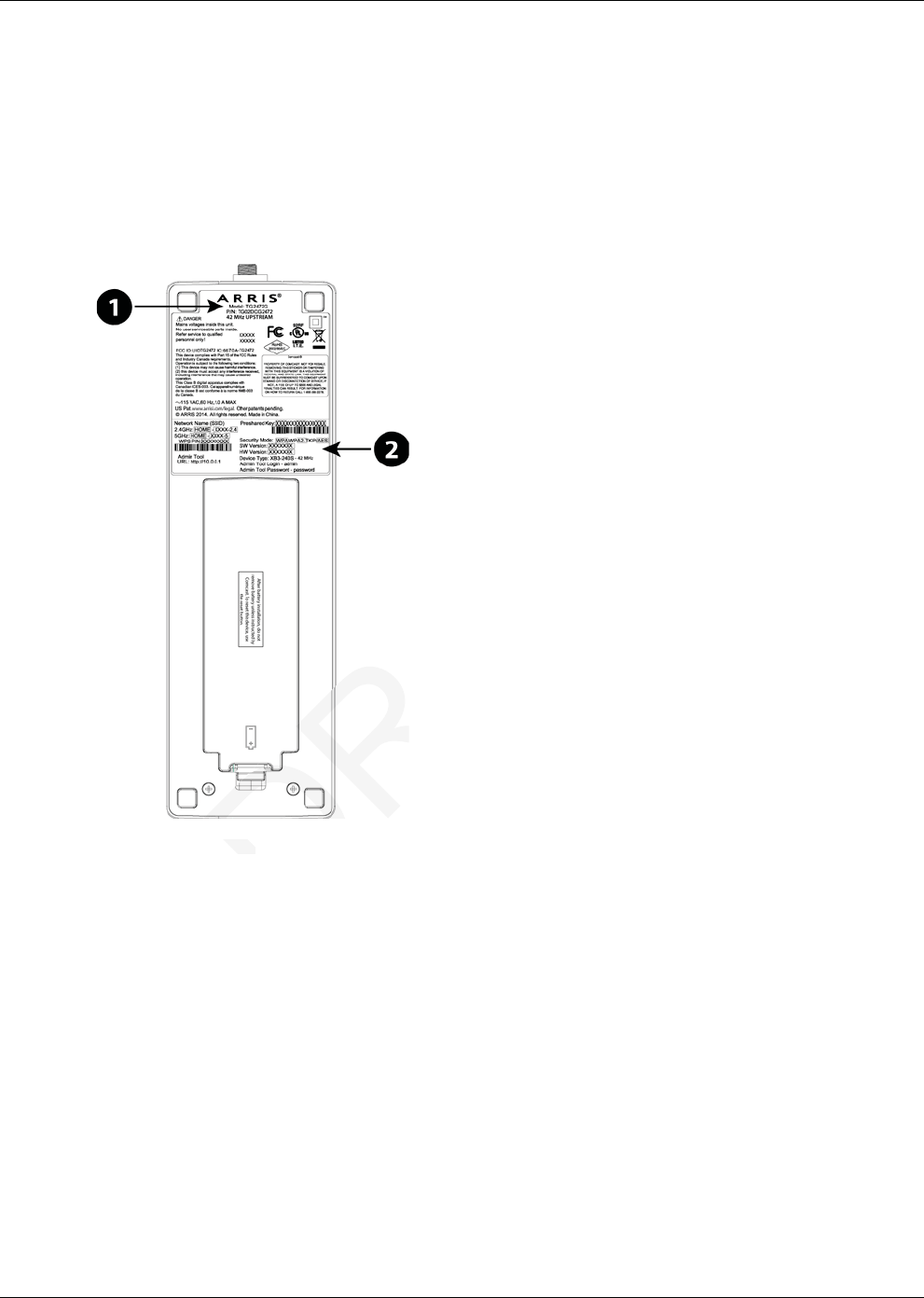
Chapter 3: Getting Started
Linux/other Unix
Hardware drivers, TCP/IP, and DHCP must be enabled in the kernel. A supported Ethernet or
wireless LAN connection must be available.
About this Manual
This manual covers the Touchstone TG2472 Telephony Gateway. The model number is on the label
affixed to the Telephony Gateway.
1. Model Number
2. Security Label
What about Security
Having a high-speed, always-on connection to the Internet requires a certain amount of
responsibility to other Internet users—including the need to maintain a reasonably secure system.
While no system is 100% secure, you can use the following tips to enhance your system’s security:
Keep the operating system of your computer updated with the latest security patches. Run the
system update utility at least weekly.
Keep your email program updated with the latest security patches. In addition, avoid opening
email containing attachments, or opening files sent through chat rooms, whenever possible.
Install a virus checker and keep it updated.
Avoid providing web or file-sharing services over your Telephony Gateway. Besides certain
vulnerability problems, most cable companies prohibit running servers on consumer-level
accounts and may suspend your account for violating your terms of service.
Release 24 DRAFT 1.0 November 2014 Touchstone TG2472 Telephony Gateway User Guide 14
DRAFT
mbermber
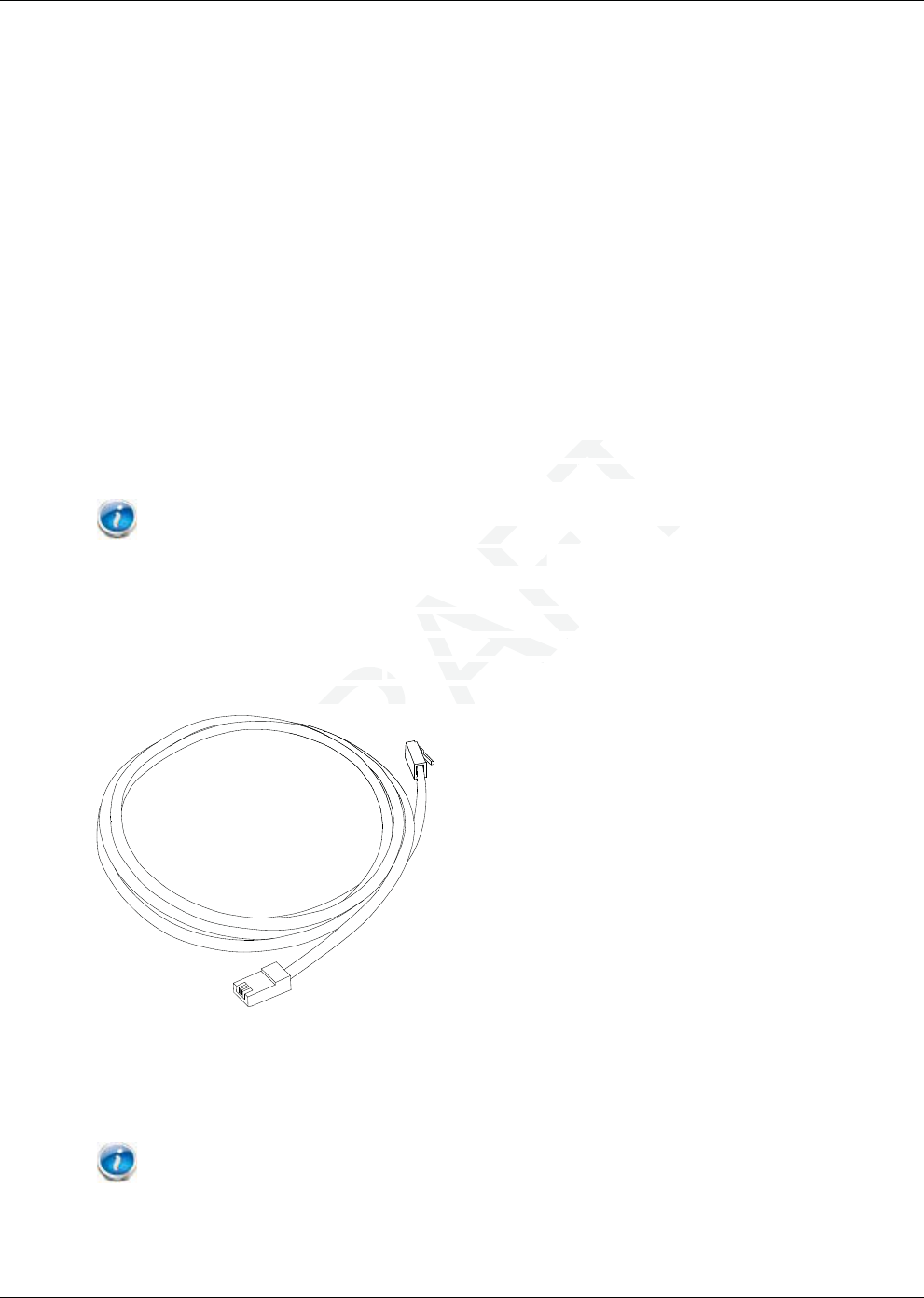
Chapter 3: Getting Started
Use the cable company’s mail servers for sending email.
Avoid using proxy software unless you are certain that it is not open for abuse by other Internet
users (some are shipped open by default). Criminals can take advantage of open proxies to hide
their identity when breaking into other computers or sending spam. If you have an open proxy,
your cable company may suspend your account to protect the rest of the network.
The TG2472 ships with wireless LAN security set by default (for the same reasons that you
should run only secured proxies). See the security label on your product for the factory security
settings. If you need to modify the default wireless security settings, see Configuring Your
Wireless Connection.
Ethernet or Wireless?
There are two ways to connect your computer (or other equipment) to the Telephony Gateway. The
following will help you decide which is best for you:
Ethernet
Ethernet is a standard method of connecting two or more computers into a Local Area Network
(LAN). You can use the Ethernet connection if your computer has built-in Ethernet hardware.
Note: To connect more than four computers to the TG2472 through the Ethernet ports, you
need an Ethernet hub (available at computer retailers).
The Telephony Gateway package comes with one 4-foot (1.2m) Ethernet cable (the connectors look
like wide telephone connectors); you can purchase more cables if necessary at a computer retailer. If
you are connecting the Telephony Gateway directly to a computer, or to an Ethernet hub with a
cross-over switch, ask for Category 5e (CAT5e) straight-through cable. CAT5e cable is required for
gigabit Ethernet (Gig-E), not regular CAT5 cable.
Wireless
Wireless access lets you connect additional (wireless-capable) devices to Telephony Gateway. The
802.11 wireless LAN standard allows one or more computers to access the TG2472 using a wireless
(radio) signal. These connections are in addition to the connections supported via Ethernet.
Note: You can use the wireless connection if your computer has a built-in or aftermarket
plug-in wireless adapter. To learn more about which wireless hardware works best with your
computer, see your computer dealer.
Both
Release 24 DRAFT 1.0 November 2014 Touchstone TG2472 Telephony Gateway User Guide 15
DRAFT
e computers ine comp
ompumpu
ter has builtter has
-
in
puters to the TG2472 throputers to the TG2472 thro
r retailers).etailers).
s with one 4s with
-
foot (1.2m) Efoot (
u can purchase more cablan purchase more ca
y Gateway directly to a coway directly to a co
egoryegory
5e 5
(CAT5e) straightAT5e) straight
ot regular CAT5 cable.ot regular CAT5 cab
R
R
R
R
R
R
R
R
R
DR
DR
DR
DR
DR
DR
R
R
R
R
R
R
R
R
R
R
R
R
R
R
R
R
R
R
R
R
R
R
R
R
R
R
R
R
R
R
R
R
R
R
R
R
R
R
R
R
R
R
R
R
R
R
R
R
R
R
R
R
R
R
R
R
R
R
R
R
R
R
R
R
R
R
R
R
R
R
R
R
R
R
R
R
R
R
R
R
R
R
R
R
R
R
R
R
R
R
R
R
R
R
R
R
R
R
R
R
R
R
R
R
R
R
R
R
R
R
R
R
R
R
R
R
R
R
DR
DR
DR
DR
DR
DR
DR
DR
DR
DR
DR
DR
DR
DR
R
R
R
R
R
R
R
R
R
R
R
R
R
R
R
R
R
R
R
R
R
R
R
R
R
R
R
R
R
R
R
R
R
R
R
DR
DR
DR
DR
DR
DR
DR
DR
DR
DR
DR
R
R
R
R
R
R
R
R
R
R
R
R
DR
DR
DR
DR
R
R
R
R
R
R
R
R
R
R
R
R
R
R
R
R
R
R
R
R
R
R
R
R
R
R
R
R
R
R
R
DR
DR
DR
DR
DR
DR
DR
DR
DR
DR
DR
DR
DR
DR
DR
DR
DR
DR
DR
DR
DR
DR
DR
R
R
R
R
R
R
R
R
R
R
R
R
R
R
R
R
R
R
R
R
R
R

Chapter 3: Getting Started
If you have two or more computers, you can use Ethernet for up to four devices and wireless for the
others. To connect five or more computers to the Ethernet ports, you will need an Ethernet hub
(available at computer retailers.)
Release 24 DRAFT 1.0 November 2014 Touchstone TG2472 Telephony Gateway User Guide 16
DRAFT
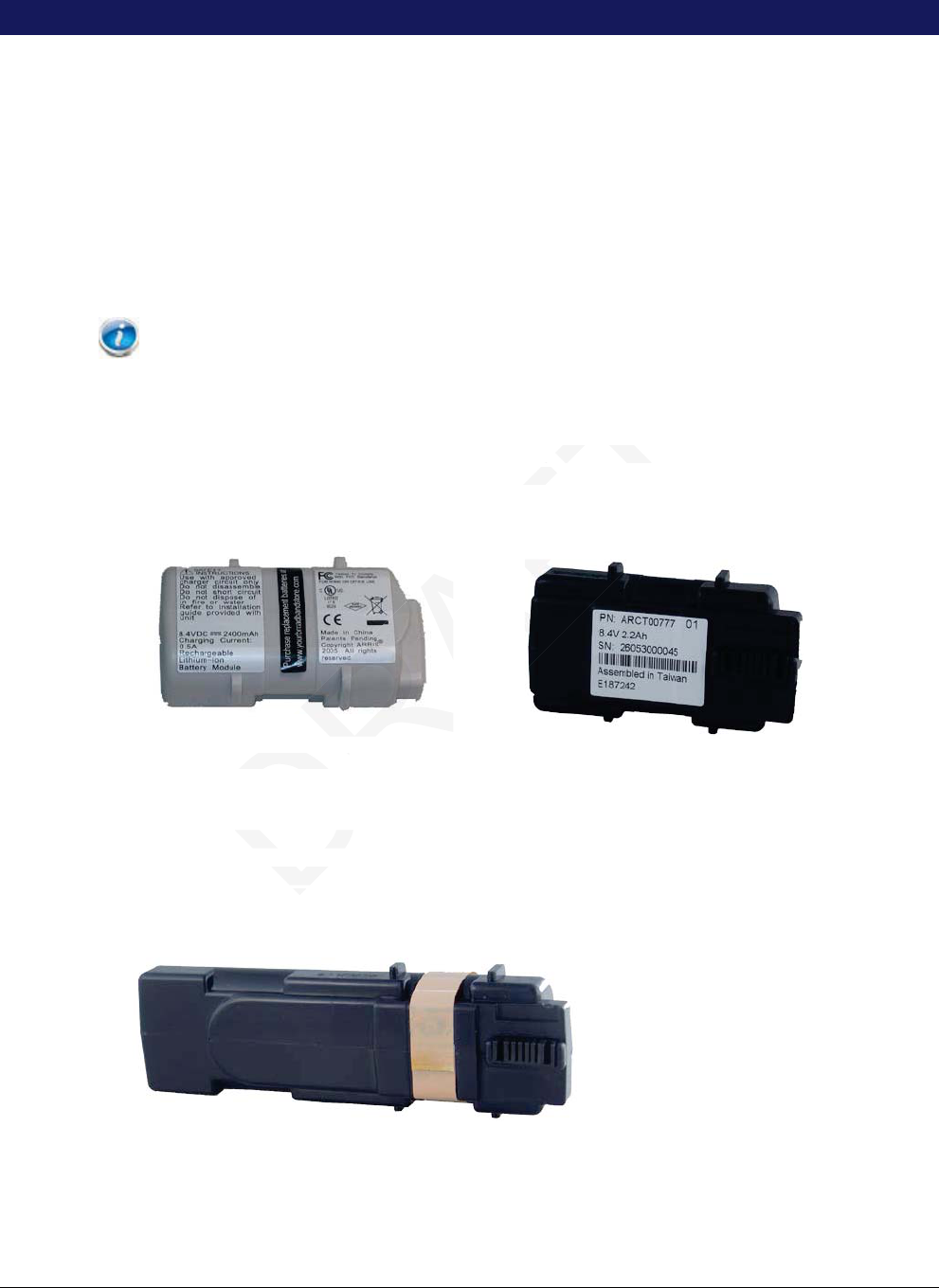
Chapter 4
Battery Installation and Removal
Introduction (Battery Installation and Removal)
The TG2472 Telephony Gateway supports a Lithium-Ion backup battery to provide continued
telephone service during power outages. The battery backup is not intended to take the place of AC
power.
Note: For safety and regulatory purposes, batteries are shipped outside of the Telephony
Gateway and must be installed.
The TG2472 supports the following battery models:
Basic backup battery: provides up to 4 hours of backup time, depending on your Telephony
Gateway model and usage. It may be light gray or black.
Basic Backup Battery (Gray)
Basic Backup Battery (Black)
Refer to Basic Battery Installation and Replacement (page 17).
Extended backup battery: provides up to 8 hours of backup time, depending on model and
usage. It has a strap between the battery guides. This is the standard battery for the TG2472.
Extended Backup Battery
Refer to Extended Battery Installation and Replacement (page 18).
Release 24 DRAFT 1.0 November 2014 Touchstone TG2472 Telephony Gateway User Guide 17
DRAFT
ackup time, dependin
ackup time, d
or black.or b
Battery (Gray)Battery (Gray)
ic Battery Instalic Battery Insta
p batterp batter
pbpb
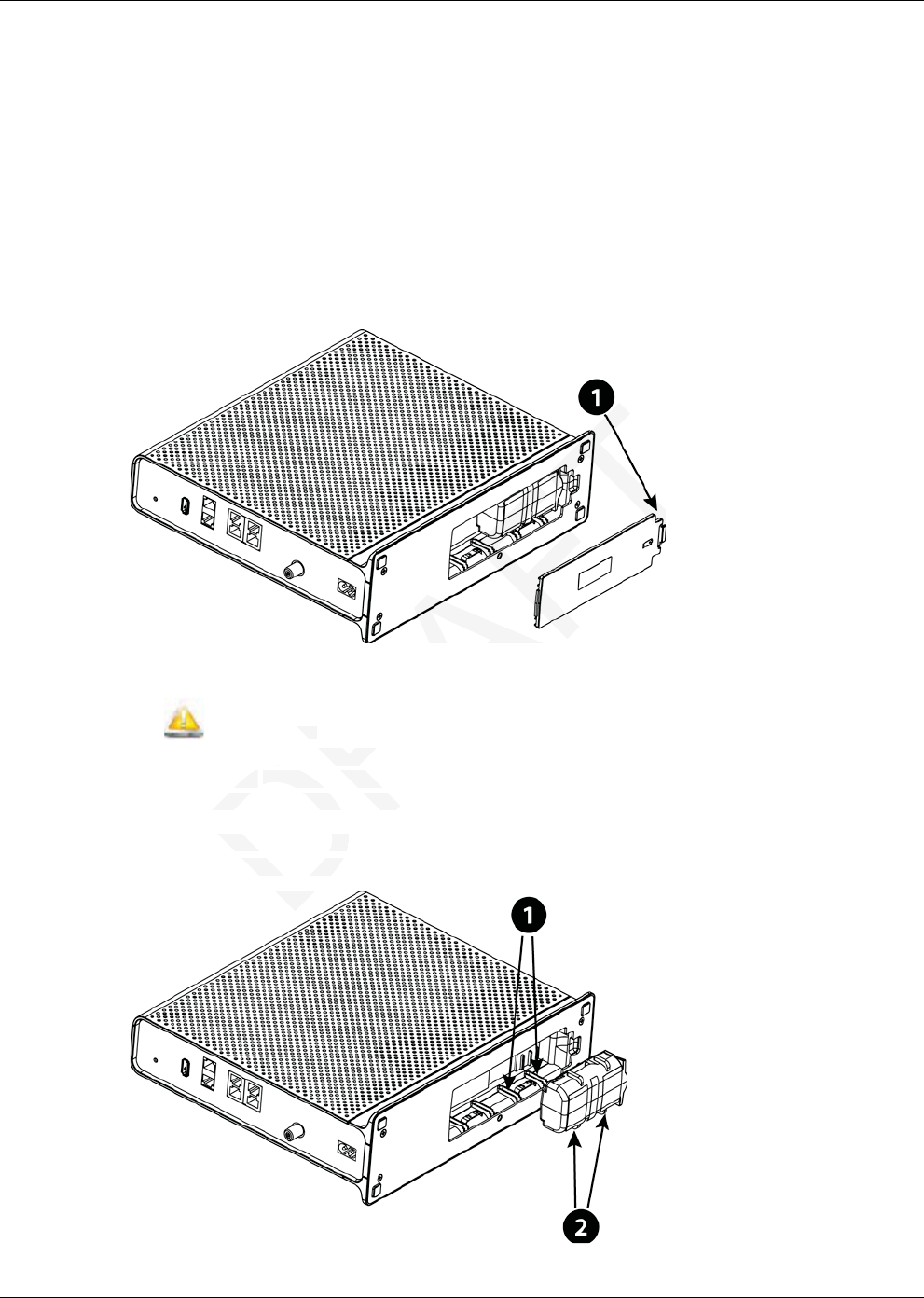
Chapter 4: Battery Installation and Removal
Your cable company may include a backup battery with your Telephony Gateway. You can order any
of the batteries shown here at http://www.arrismodemsite.com.
Basic Battery Installation and Replacement
This model of the Telephony Gateway has the ability to provide continued telephone service during
power outages. The battery backup is not intended to take the place of AC power.
Use this procedure to install and to replace the backup battery.
1. Press down and pull back on the latch holding the battery door (on the bottom of the Telephony
Gateway). Pull the door toward you. Set the door aside in a safe place.
1 - Latch End
CAUTION
Risk of equipment damage
Improperly inserting the battery may damage the battery connector in the Telephony
Gateway. Carefully follow the instructions in the next step to avoid damage.
2. Hold the battery pack so that the guides on the battery align with the slots on the Telephony
Gateway and slide the battery into the bay.
Release 24 DRAFT 1.0 November 2014 Touchstone TG2472 Telephony Gateway User Guide 18
DRAFT
IONON
quipment damageuipment dam
erly erly
inserting the battery minserting the ba
way. Carefully follow the iway. Carefully follow the
attery pack so that attery pack so th
slide the batteslide the batt
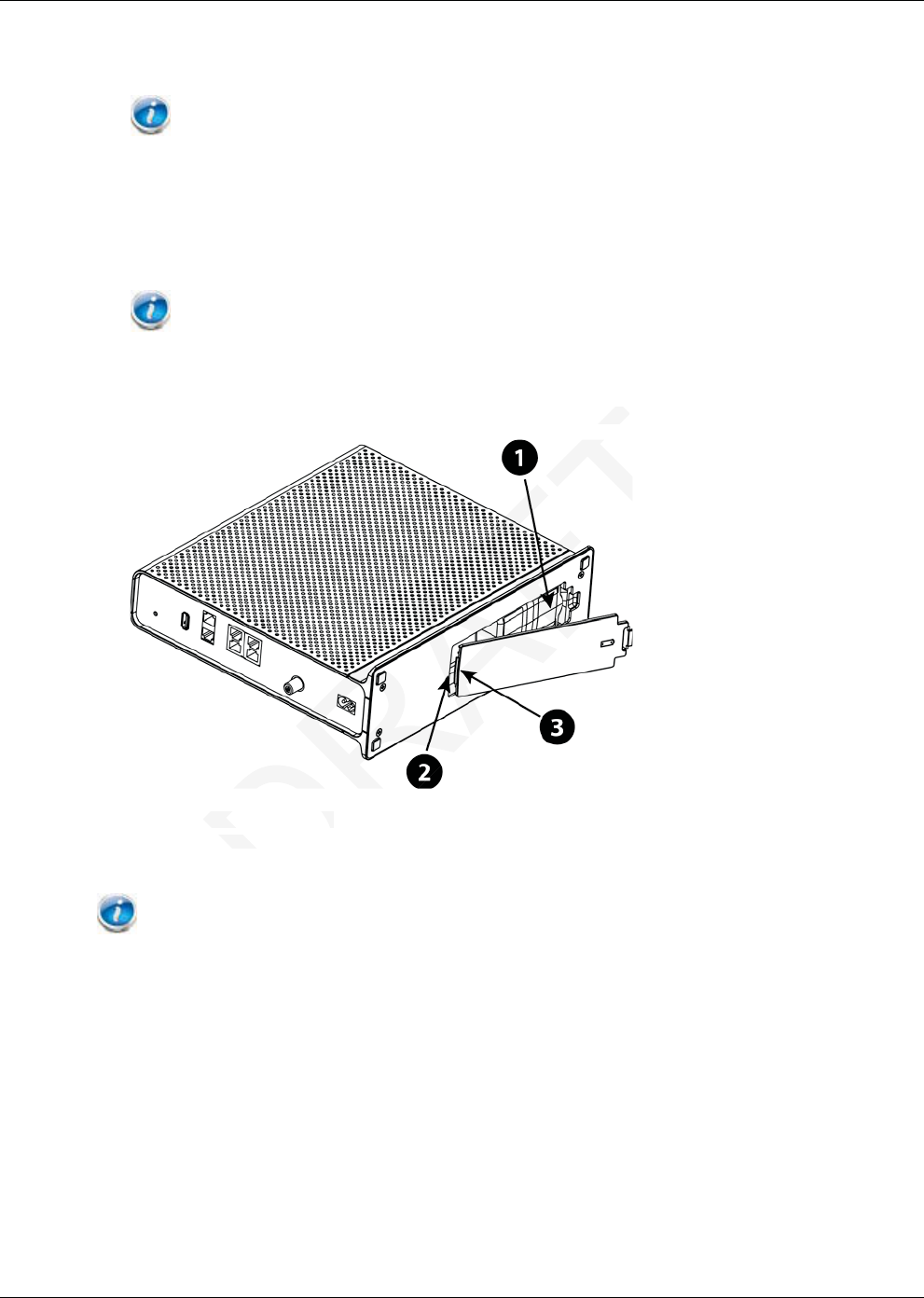
Chapter 4: Battery Installation and Removal
1 - Battery Slots
2 - Battery Guides
Note: Batteries will not insert completely into the Telephony Gateway if not oriented
correctly. The battery should slide into the bay without significant force. Line up the guides on
the battery with the slots in the battery bay.
3. Push the battery pack into the bay until it seats into place. If you are taking the battery out
of the Telephony Gateway, position your finger in the battery opening area and use
leverage to dislodge the battery while pulling it straight back.
Note: The Telephony Gateway will not begin operating until you apply AC power.
4. Replace the door. To do so, place the hinge tabs of the battery door into the receiver slots inside
the Telephony Gateway battery compartment on the opposite end of the battery opening. Rotate
the door toward the unit until the latch snaps back into place.
1 - Battery Compartment
2 - Receiver Slot
3 - Hinge Tab
Note: Telephony Gateways use a Lithium-Ion battery pack. Please recycle or dispose of the
battery responsibly and in accordance with local ordinances.
Extended Battery Installation and Replacement
This model of the Telephony Gateway has the ability to provide continued telephone service during
power outages. The battery backup is not intended to take the place of AC power.
Use this procedure to install or replace the backup battery.
Release 24 DRAFT 1.0 November 2014 Touchstone TG2472 Telephony Gateway User Guide 19
DR
ry Compartment
ry Compartment
er Sloter Slo
FT
lace.lace
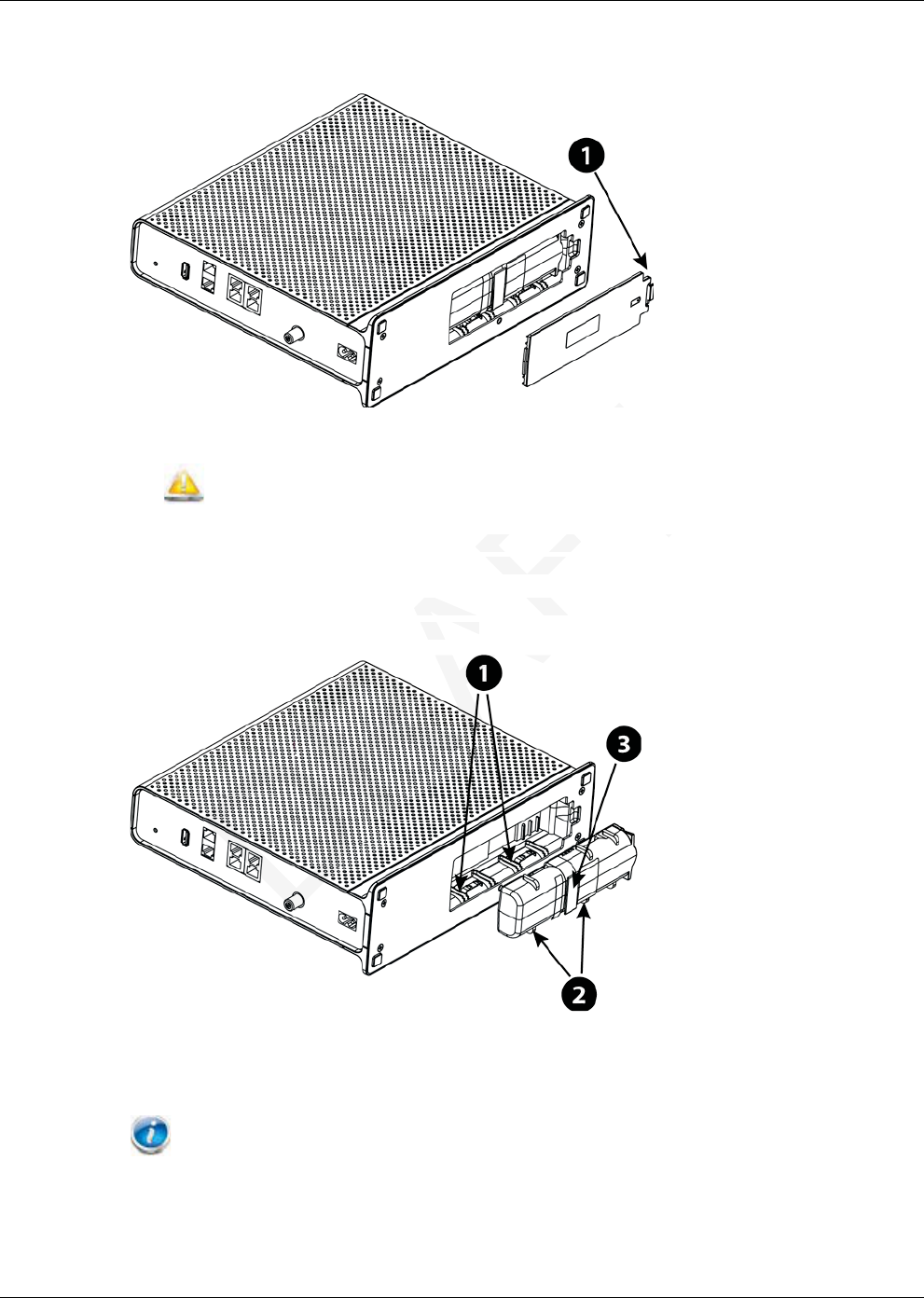
Chapter 4: Battery Installation and Removal
1. Press down and pull back on the latch holding the battery door (on the bottom of the Telephony
Gateway). Pull the door toward you. Set the door aside in a safe place.
1 - Latch End
CAUTION
Risk of equipment damage
Improperly inserting the battery may damage the battery connector in the Telephony
Gateway. Carefully follow the instructions in the next step to avoid damage.
2. Hold the battery pack so that the guides on the battery align with the slots on the Telephony
Gateway and slide the battery into the bay.
1 - Battery Slots
2 - Battery Guides
3 - Battery Pull Strap
Note: Batteries will not insert completely into the Telephony Gateway if not oriented
correctly. The battery should slide into the bay without significant force. Line up the slots in the
battery bay with the guides on the battery and apply even pressure on both ends of the battery.
3. Push the battery pack into the bay until it latches into place. If you are taking the battery
out of the Telephony Gateway, use the battery pull strap to dislodge the battery.
Release 24 DRAFT 1.0 November 2014 Touchstone TG2472 Telephony Gateway User Guide 20
RAFT
damage the battery conndamage the battery conn
ructions in the next step tons in the n
guides on the battery aliguides on the battery
into the bay.the bay.
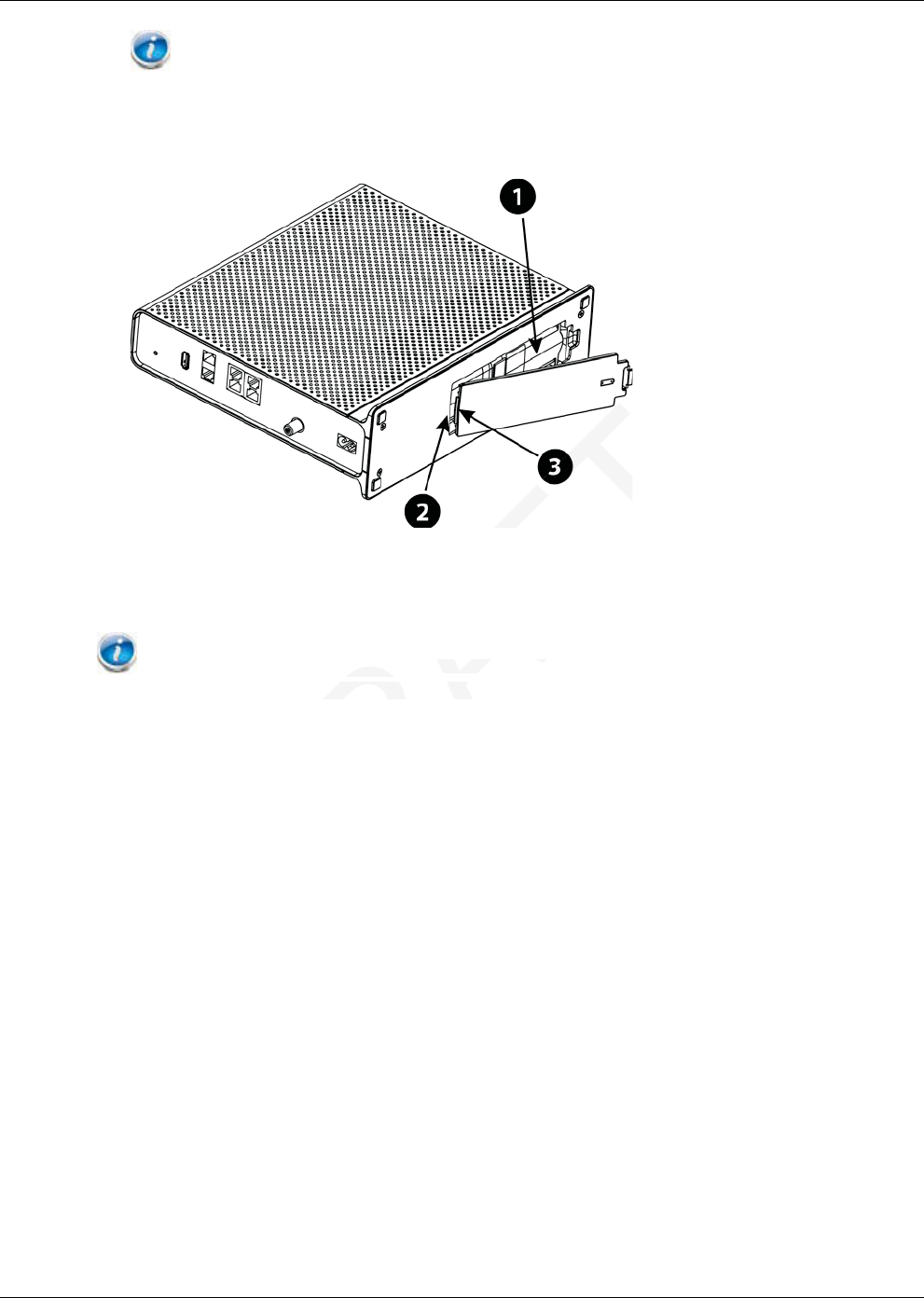
Chapter 4: Battery Installation and Removal
Note: The Telephony Gateway will not begin operating until you apply AC power.
4. Replace the door. To do so, place the tabs of the battery door into the slot inside the Telephony
Gateway battery compartment. Rotate the door toward the front of the Telephony Gateway until
the latch snaps back into place.
1 - Battery Compartment
2 - Receiver Slot
3 - Hinge Tab
Note: Telephony Gateways use a Lithium-Ion battery pack. Please recycle or dispose of the
battery responsibly and in accordance with local ordinances.
Release 24 DRAFT 1.0 November 2014 Touchstone TG2472 Telephony Gateway User Guide 21
DRAFT
ways useways u
a LithiumLithium
-
Ion bb
accordance with local ordaccordance with loc

Chapter 5
Installing and Connecting your Telephony Gateway
Before you start, make sure that:
You have contacted your cable company and verified that they provide data and telephone
service using standard DOCSIS technology.
You have all the items you need.
Cable, phone, and power outlets are available near the computer. If a cable outlet is not
conveniently located, your cable company can install a new one.
If you have ordered service, your cable company should configure the Telephony Gateway
automatically. You need only follow the instructions in this section to install and connect the
Telephony Gateway.
CAUTION
Risk of equipment damage
Only qualified installation technicians should connect the Telephony Gateway to house wiring.
Incumbent telephone service must be physically disconnected at the outside interface box before
making any connections.
Release 24 DRAFT 1.0 November 2014 Touchstone TG2472 Telephony Gateway User Guide 22
DRAFT
ectionectio
d connect the Telephony Gconnect the Telephony G
sically disconnected at they disconne
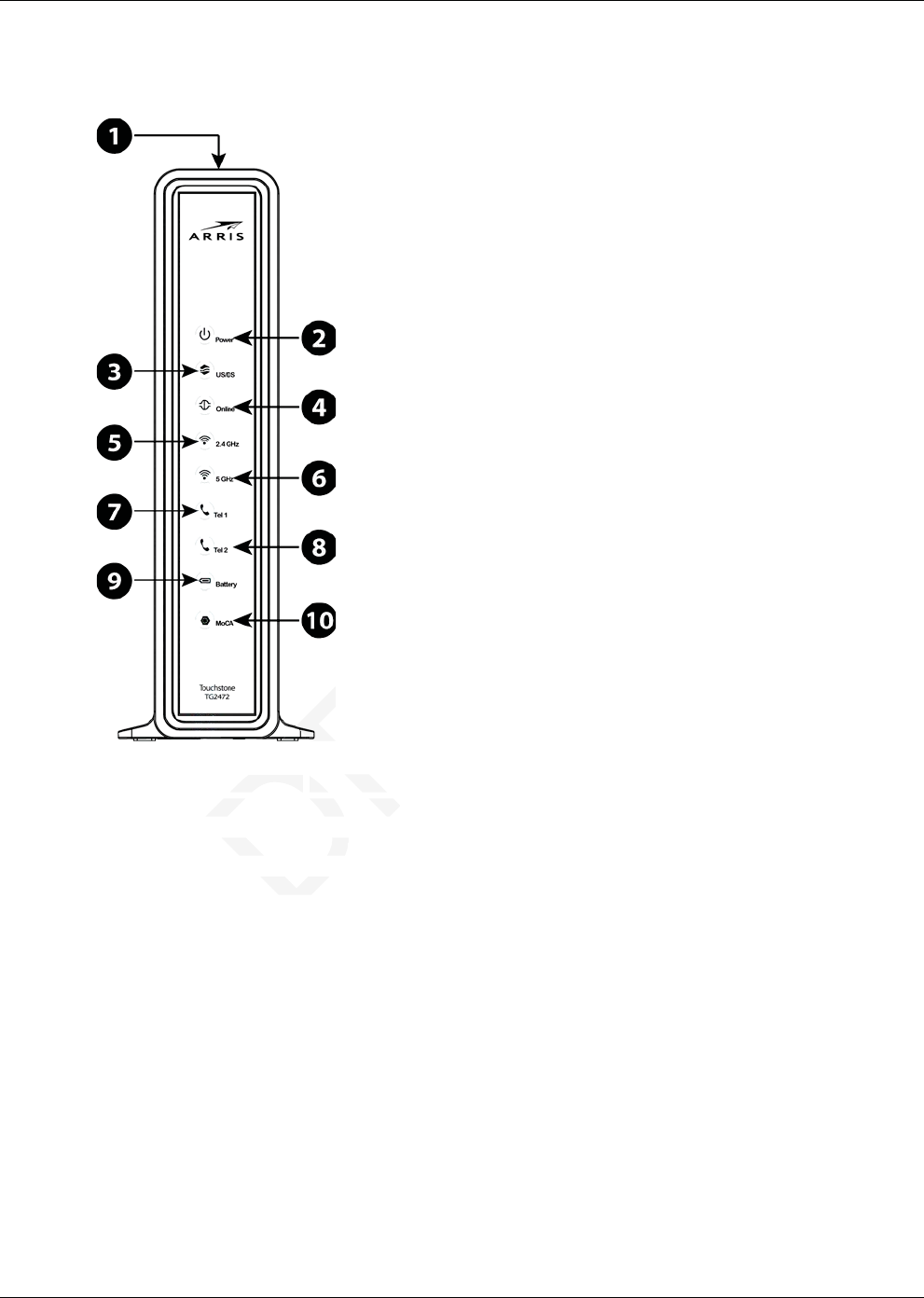
Chapter 5: Installing and Connecting your Telephony Gateway
Front Panel
The front of the Telephony Gateway has the following indicators.
1. WPS Button/LED: begins associating the Telephony Gateway with a wireless device. LED
indicates Wireless Protected Setup (WPS) is active.
2. Power: indicates whether AC power is available to the unit.
3. US/DS: indicates upstream/downstream connectivity.
4. Online: indicates internet data transmission status.
5. 2.4 GHz: indicates the status of the 2.4 GHz wireless LAN.
6. 5 GHz: indicates the status of the 5 GHz wireless LAN.
7. Tel 1: indicates the status of telephone line 1.
8. Tel 2: indicates the status of telephone line 2.
9. Battery: indicates the battery status.
10. MoCA: indicates connectivity between the Telephony Gateway and other home devices
connected via the MoCA network.
Release 24 DRAFT 1.0 November 2014 Touchstone TG2472 Telephony Gateway User Guide 23
DRAFT
on/LED:on/LED:
begins associatbegins ass
Wireless Protected SetupWireless Protected Setu
dicates whether ACdicates whether
tes upstretes upstre
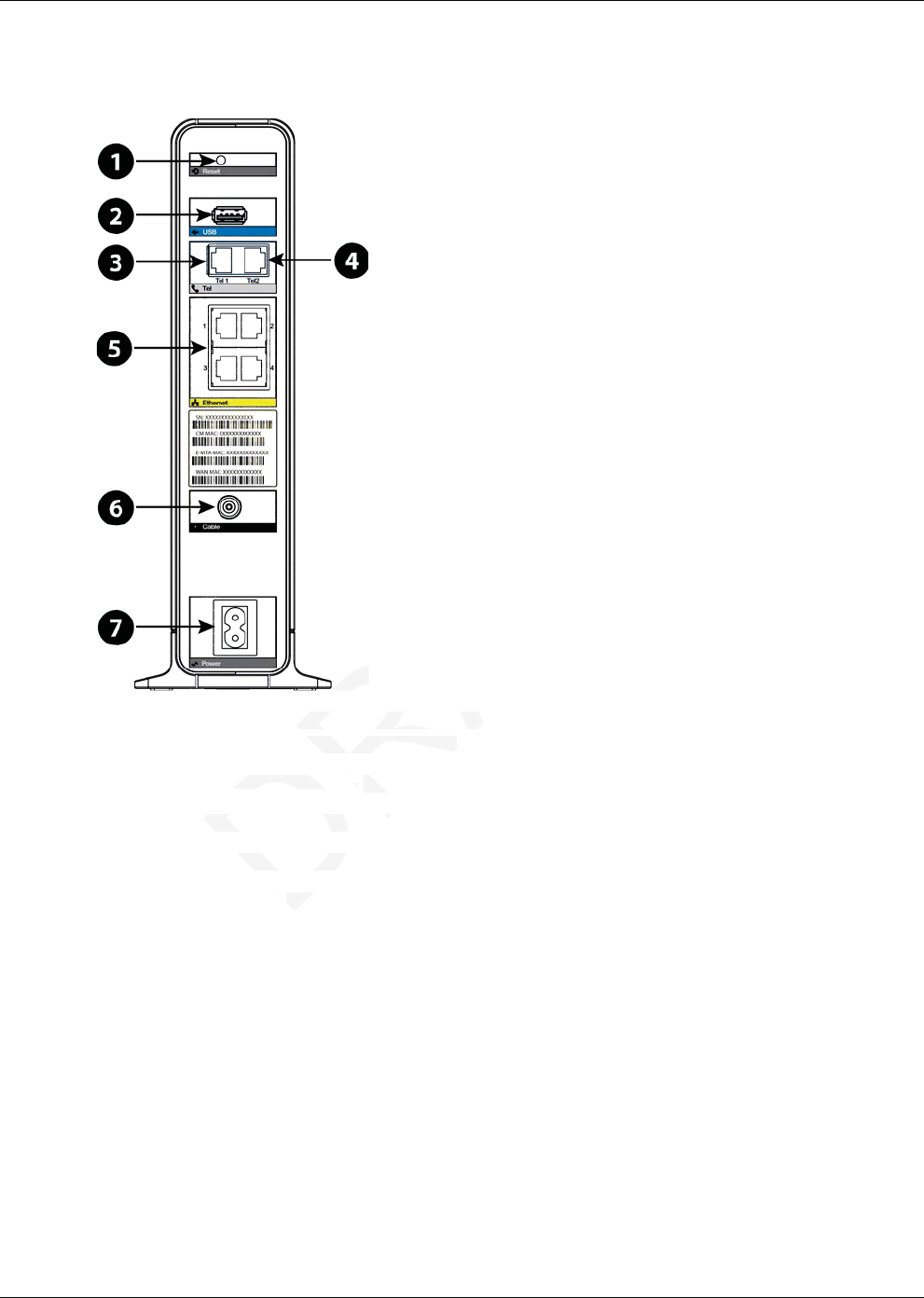
Chapter 5: Installing and Connecting your Telephony Gateway
Rear Panel
The rear of the Telephony Gateway has the following connectors and controls.
1. Reset button: resets the Telephony Gateway as if you power cycled the unit. Use a pointed
non-metallic object to press this button.
2. USB: USB host connector - future support for external USB devices
3. Tel 1: connector for the first phone line.
4. Tel 2: connector for the second phone line.
5. Ethernet (1 - 4): connectors for use with a computer LAN port.
6. Cable: connector for the coaxial cable.
7. Power: connector for the power cord.
Selecting an Installation Location
There are a number of factors to consider when choosing a location to install your Telephony
Gateway:
Is an AC outlet available nearby? For best results, the outlet should not be switched and should
be close enough to the Telephony Gateway that extension cords are not required.
Is a cable jack available? For best performance, keep the number of splitters between the jack
and cable drop to a minimum. Each splitter attenuates (reduces) the signal available to the
Telephony Gateway. A large number of splitters can slow down the Internet connection and even
affect your telephone service.
Release 24 DRAFT 1.0 November 2014 Touchstone TG2472 Telephony Gateway User Guide 24
DRAFT
ets the Telephony Gatewaets the Telephony Gatew
ect to press this button.o press this button.
host connector host connector
- -
future sufutu
onnector for the first pho
onnector for the first pho
ector for the secector for the se
concon
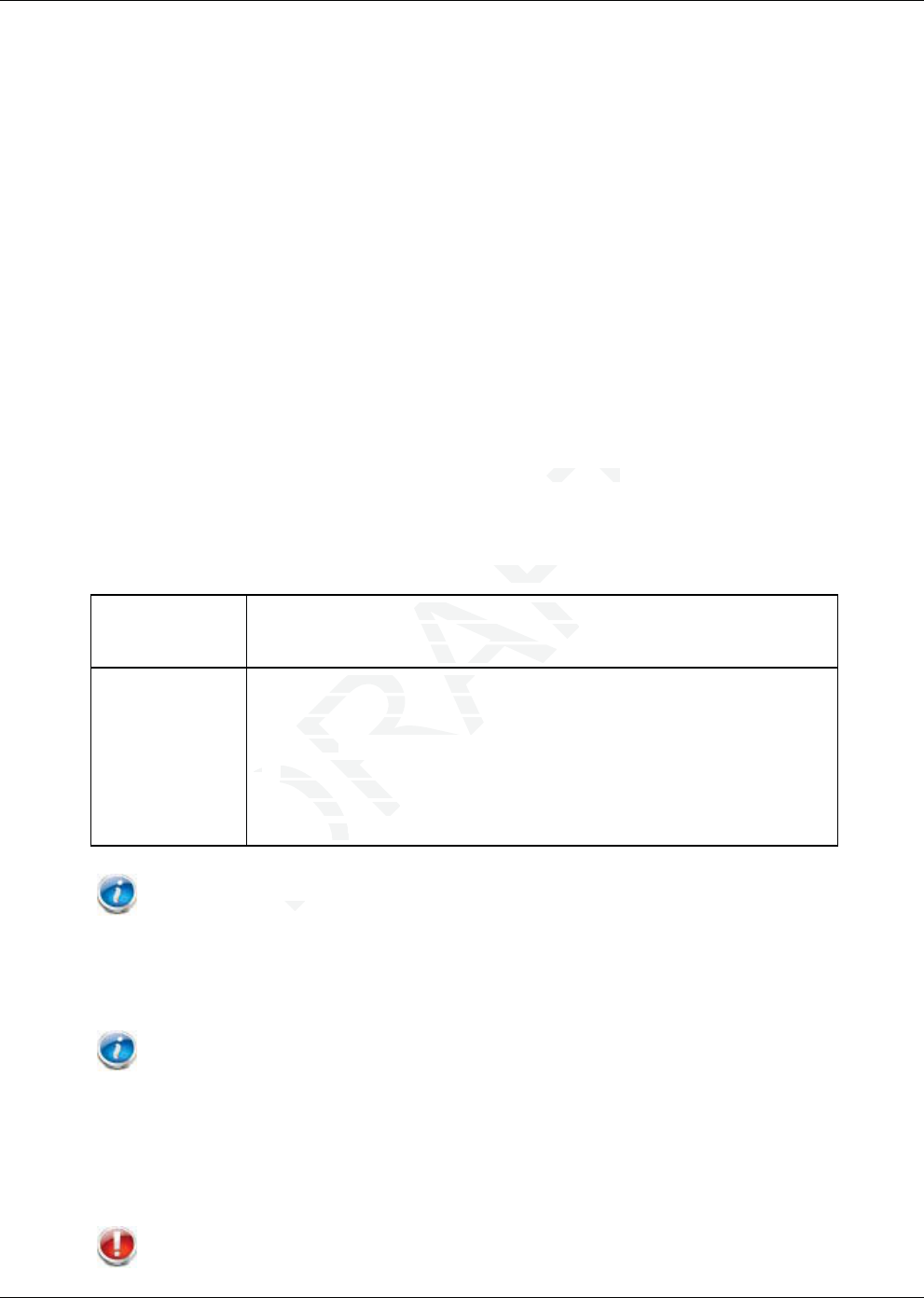
Chapter 5: Installing and Connecting your Telephony Gateway
Can you easily run cables between the Telephony Gateway’s location and the phones?
If you are connecting devices to the Ethernet ports, can you easily run cables between the
Telephony Gateway’s location and those devices?
If you want to install the Telephony Gateway on a desktop, is there enough space on either side
to keep the vents clear? Blocking the vents may cause overheating.
How close are your wireless devices? The Telephony Gateway wireless connection range is
typically 100–200 feet (30m–65m). A number of factors can affect connection range, as
described below.
Desktop Mounting Instructions
Position the Telephony Gateway so that:
air flows freely around it
the back faces the nearest wall
it will not fall to the floor if bumped or moved
the ventilation holes on the sides of the unit are not blocked
Factors Affecting Wireless Range
A number of factors can affect the usable range for wireless connections.
Increases range Raising the unit above the devices (for example, installing the
Telephony Gateway in the upper floor of a multi-story dwelling)
Adding a wireless extender to the network
Decreases range Lowering the unit below the devices (for example, installing the
Telephony Gateway in a basement)
Metal or concrete walls between the Telephony Gateway and other
devices
Large metal appliances, aquariums, or metal cabinets between the
Telephony Gateway and other devices
Interference and RF noise (2.4 GHz wireless phones, microwave
ovens, or other wireless networks)
Note: Note that decreasing the range of your wireless network may be beneficial, as long as
the decreased range is sufficient for your needs. By limiting your network’s range, you reduce
interference with other networks and make it harder for unwanted users to find and connect to your
network.
Note: Setting the transmit power level to High increases the range. Setting it to Medium or
Low decreases the range proportionately.
Connecting the Telephony Gateway
WARNING
Risk of injury or equipment damage
Release 24 DRAFT 1.0 November 2014 Touchstone TG2472 Telephony Gateway User Guide 25
DRA
ring the unit below the dering the unit below
ephony Gateway in a baseephony Gateway in a
Metal or concrete walls beetal or concrete walls b
devicesvices
Large metal appliancLarge metal
Telephony GatewaTelephony Ga
Interference anrference an
ovens, or oth, or
RAFT
ot blockedt blocked
range for wireless connecfor wirele
it above the devices (for eabove the devices (f
Gateway in the upper floorway in the upper floo
wireless extender to the nextender to the
AF
RA
D
D
D
D
tdtd
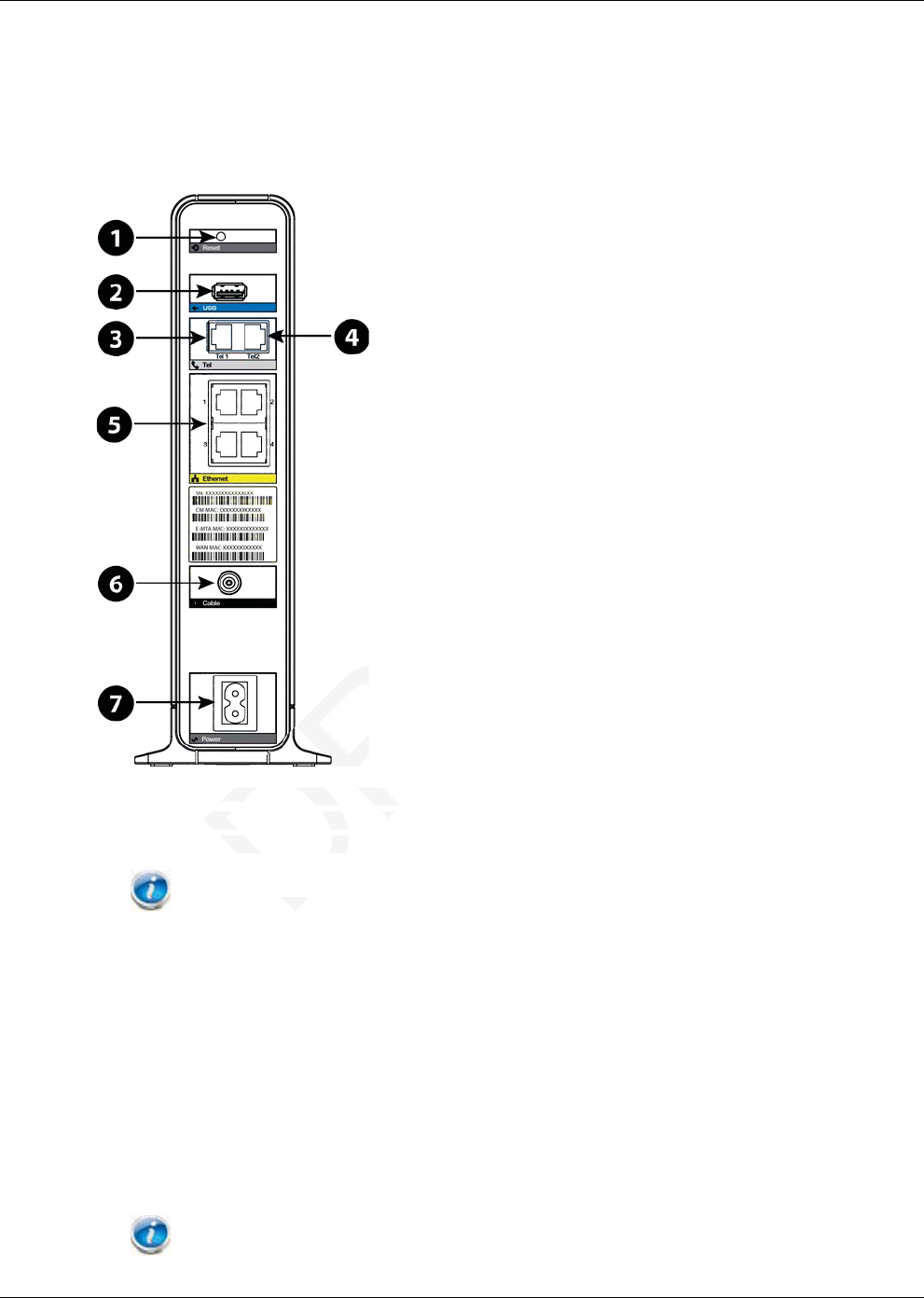
Chapter 5: Installing and Connecting your Telephony Gateway
Connecting the Telephony Gateway to the home’s existing telephone wiring should only be
performed by a professional installer. Physical connections to the previous telephone provider must
be removed and the wiring must be checked; there must not be any voltage. Cancelation of telephone
service is not adequate. Failure to do so may result in loss of service and/or permanent damage to
the Telephony Gateway.
1. Connect one end of the coax cable to the cable outlet or splitter, and the other end to the
Telephony Gateway’s Cable connector (6). Tighten the connections by hand, then tighten an
additional 1/8 turn with a wrench.
Note: For best performance, use high-quality coax cable and minimize or eliminate
splitters between the cable jack and the Telephony Gateway. If you are using MoCA for your
home network, MoCA filters must be installed on any legacy client devices. Your cable company
will install these filters for you.
2. Insert the plug from the power cord into the Power connector on the back of the Telephony
Gateway (7) and insert the power cord into a convenient AC outlet.
The Power light on the front of the Telephony Gateway lights up, then flashes once (refer to the
LED tables shown in Using the Telephony Gateway). See Troubleshooting (page 37) if the Power
light does not turn on.
3. Connect one end of the Ethernet cable to any Ethernet port on the back of the Telephony
Gateway, (5) and the other end to the Ethernet port on a computer, hub, or broadband router.
Note: If you are connecting to a computer, use the Ethernet cable included in the
Telephony Gateway package.
Release 24 DRAFT 1.0 November 2014 Touchstone TG2472 Telephony Gateway User Guide 26
DRAFT
ne end of tne end of t
he coax cable the coax cabl
ny Gateway’s Cable conn
ny Gateway’s Cable conn
1/8 turn with a wre1/8 turn with a w
bestbest

Chapter 5: Installing and Connecting your Telephony Gateway
4. Connect one end of the telephone cable to the telephone port on the back of the Telephony
Gateway (3 or 4). Connect the other end to the telephone.
Configuring Your Wireless Connection
The TG2472 ships with wireless LAN security set by default. See the security label on your product
for the factory security settings.
Note: You must set up your computer and other client devices to work with the security
settings on the TG2472. Refer to the documentation for your client device for instructions on setting
security. On most computer systems you only need to select the network name (SSID) device and
enter the encryption key. If your computer or client device supports Wi-Fi Alliance WPS (Wireless
Protected Setup), activate WPS on your computer or client device and the TG2472 simultaneously to
easily set up your system security.
If you need to modify the Telephony Gateway’s default wireless security settings, or if you want to
configure any other wireless LAN settings, refer to the following instructions.
Accessing the Configuration Interface
Follow these steps to access the configuration interface. You should have already set up the TG2472
as described in Installing and Connecting Your Telephony Gateway (page 21).
1. If security has been properly set up on your computer to access the wireless LAN on the TG2472,
use the connection utility for your operating system to connect to the wireless LAN using its
network name (SSID), as shown on the security label.
2. If you cannot access the wireless LAN, you must first establish a wired Ethernet connection
between your computer and the TG2472.
3. In your web browser, open the page http://192.168.0.1/ to access the wireless router setup.
The Login screen displays.
Note: The default user name is “admin”. The default password is “password”, in lower
case letters.
4. Enter the user name and password and click the Apply button to log in.
The System Basic Setup screen displays.
5. Use the online help information to set configuration parameters as required.
Note: Most configuration parameters that you may want to set can be accessed on the
System Basic Setup screen, including the security mode and setting a system password.
Setting Parental Controls
The Parental Control feature allows you to block specified keywords and web sites from being
accessed and also to specify trusted computers in the network. Trusted computers are not affected by
the parental control settings.
Release 24 DRAFT 1.0 November 2014 Touchstone TG2472 Telephony Gateway User Guide 27
DRAFT
ess secuess se
lowing instrulowin
interface. You should hainterface. You should ha
Your Telephony GatewayTelephony
p on your computer to acp on your computer
our operating system to coperating system to
own on the security labelthe security labe
e wireless LAN, you muste wireless LAN, you
uter and the TG2472.uter and the TG2472.
owser, open the page httpwser, open the page http
screen displays.screen display
e:e:
The default The default
usu
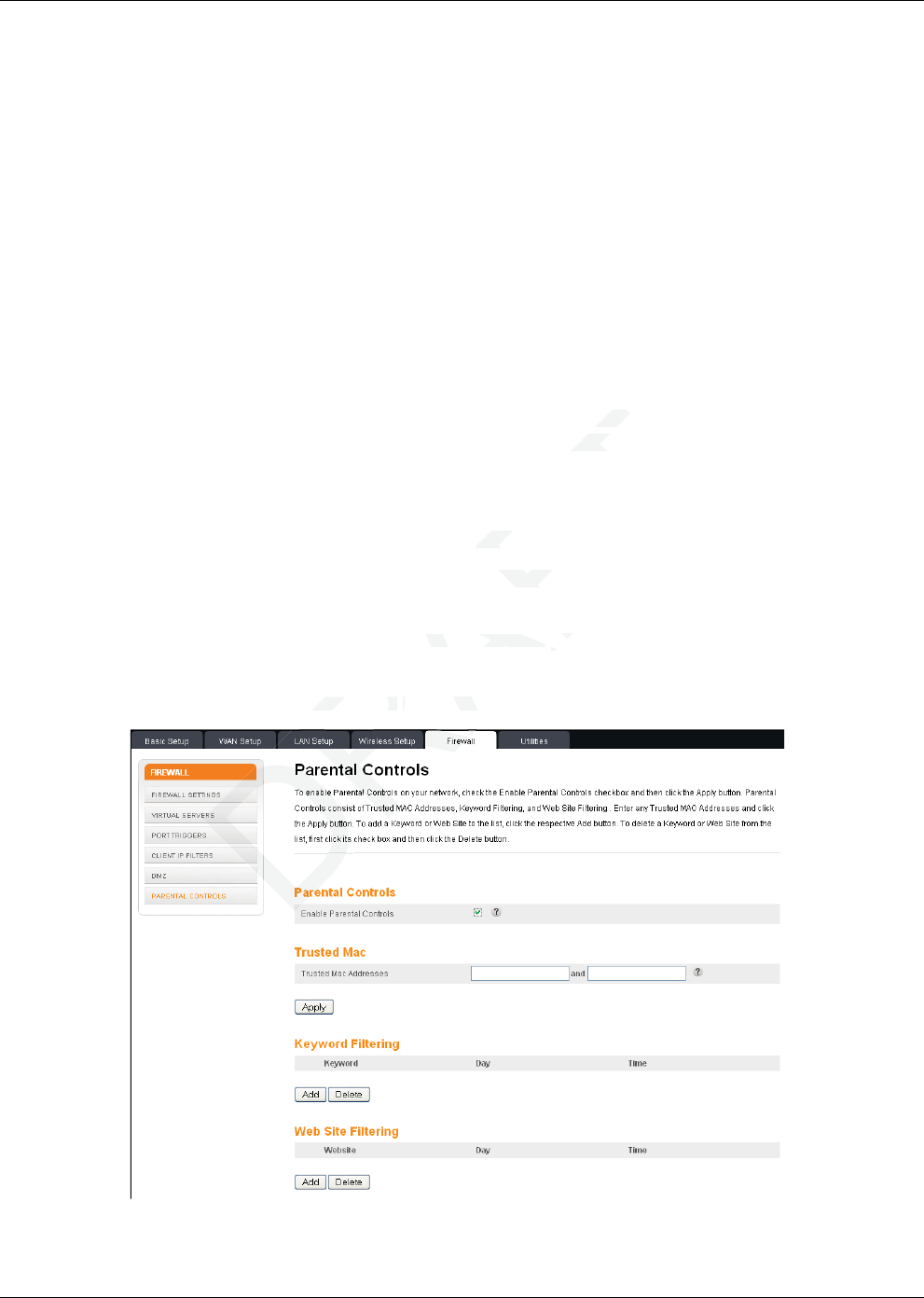
Chapter 5: Installing and Connecting your Telephony Gateway
Finding the MAC Address of a Computer
In order to set up trusted computers you must first determine the MAC address of those computers.
Use the operating system of your computer to find its MAC address, as follows:
Windows: from the Start menu, find and select the Control Panel. Double-click Network Connections
(Windows XP), or Network & Sharing Center (Windows Vista or Windows 7). Then double-click either
“Wireless Network Connection” for a wireless connection, or “Local Area Connection” for an
Ethernet connection. Next click the Details button (Windows Vista or Windows 7), or click the
Support tab and then the Details button (Windows XP). The “Physical Address” line shows the MAC
address.
MacOS X: open System Preferences and click the Network icon. To find the Ethernet MAC address,
select Built-in Ethernet from the Show drop-down, then click the Ethernet tab. The “Ethernet ID” field
shows the MAC address. To find the wireless MAC address, select Airport from the Show drop-down,
then click the Airport tab. The “Airport ID” field shows the MAC address.
Linux: open a shell window and type /sbin/ifconfig (and press Enter). The wireless interface is
eth1 (unless there is no Ethernet adapter, in which case the interface is eth0).
Making Your Parental Control Settings
Follow these steps to set up your Parental Controls:
1. Access and log into the wireless configuration interface as explained in Accessing the
Configuration Interface (page 26).
2. Click the Firewall tab and then click Parental Controls in the side menu to display the Parental
Controls screen.
3. Check the Enable Parental Controls checkbox and click the Apply button.
4. Configure any or all of the following parental controls:
Trusted MAC Addresses:
Release 24 DRAFT 1.0 November 2014 Touchstone TG2472 Telephony Gateway User Guide 28
RAFT
nd presnd pr
he interface ihe inte
ntrols:trols
guration interface as expn interf
click
Parental ControlsParental Controls
in tin t
ntal Controlsntal Controls
checkbox andcheckbox
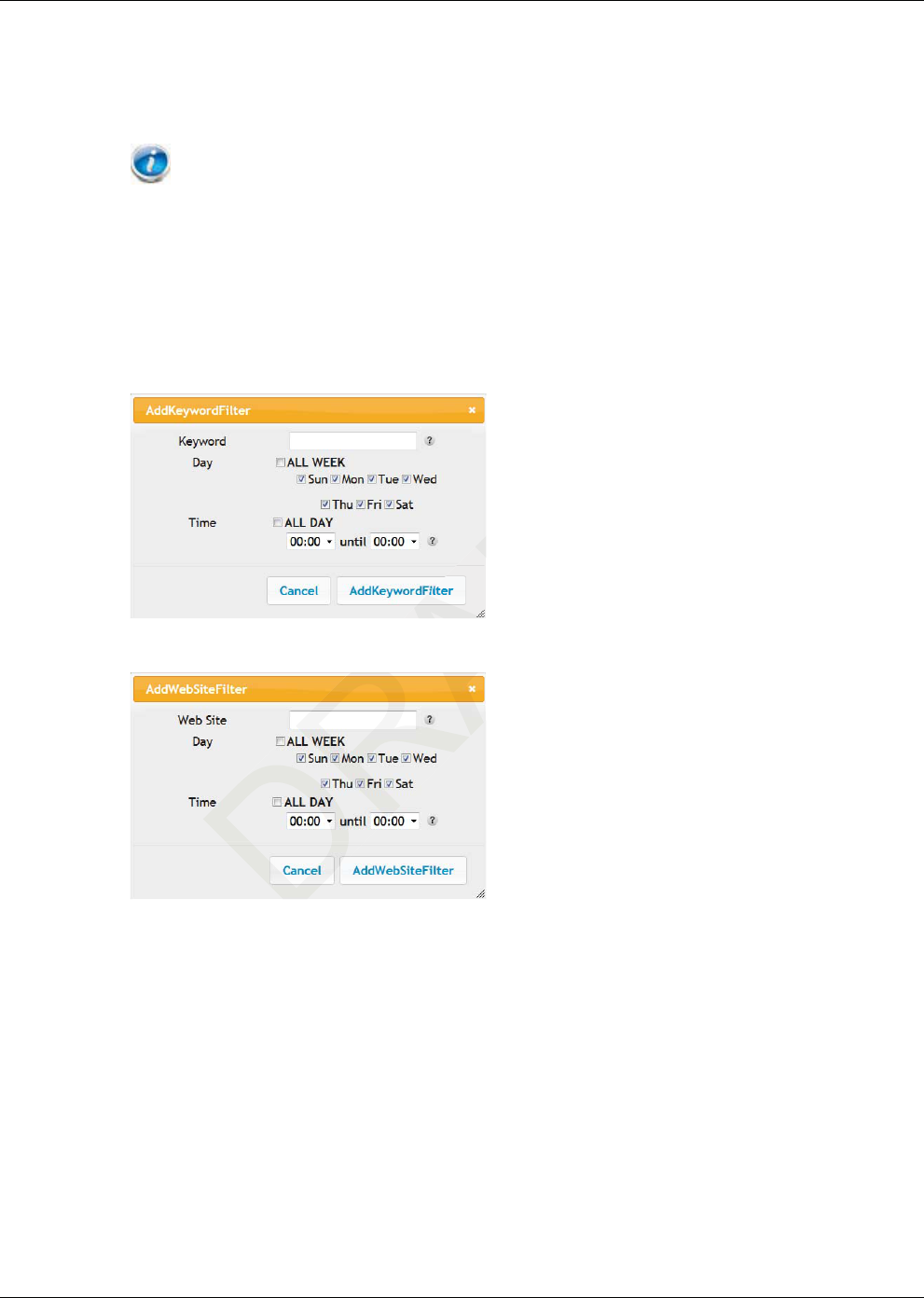
Chapter 5: Installing and Connecting your Telephony Gateway
Enter the MAC addresses of any “trusted” computers on the network and click the Apply button.
You can add two trusted computers. Once added, these trusted computers will not be affected by
the parental control settings. For example, you may want the computers of the father and
mother to be trusted, while the childrens’ computers have parental controls in effect.
Note: Refer to the Finding the MAC Address of a Computer (page 27) for information on
determining the MAC address of your computer.
Keyword and Web Site Filtering:
You can add a list of keywords and web sites that you want to block. To add a keyword or web site
to the list, click the respective Add button. To delete a keyword or web site from the list, first click
its check box and then click the Delete button.
Add Keyword Filter Dialog Box
Add Web Site Filter Dialog Box
Adding a Keyword or Web Site Filter
a. Enter the keyword in the Keyword field or web site URL address in the Web Site field.
b. Click the checkboxes for the days you want access blocked, or click the All Week checkbox
for all week.
c. Set the start time and end time during the specified days (24-hour clock). (0:00 until 0:00
indicates all day, or just click the All Day checkbox.)
d. Click the Add Keyword Filter or Add Web Site Filter button respectively. Then click the Apply
button.
Release 24 DRAFT 1.0 November 2014 Touchstone TG2472 Telephony Gateway User Guide 29
DRAFT
Box

Chapter 6
Configuring Your Ethernet Connection
If your computer is equipped with a LAN card providing an Ethernet connection, you may have to
configure your computer’s TCP/IP settings. The steps that follow will guide you through setting your
computer’s TCP/IP settings to work with the Telephony Gateway.
Requirements
Make sure you have the following before attempting to configure your Ethernet connection:
Computer with Ethernet interface
Ethernet cable (supplied)
IP address, subnet, gateway, and DNS information for installations not using DHCP
How to use this Chapter
The following list shows the procedures for modifying the TCP/IP settings on the computer. The
procedure is slightly different depending on the operating system that you are using. Please ensure
you are using the correct steps for the operating system on your computer. Follow the links below for
instructions to configure your Ethernet connection on your operating system.
TCP/IP Configuration for Windows XP (page 29)
TCP/IP Configuration for Windows Vista (page 30)
TCP/IP Configuration for Windows 7 and Windows 8 (page 30)
TCP/IP Configuration for MacOS X (page 31)
TCP/IP Configuration for Windows XP
Follow these steps to configure the Ethernet interface on a Windows XP operating system.
TCP/IPv6 Note: This procedure shows the configuration of TCP/IPv4. TCP/IPv6 is not
installed or enabled by default in Windows XP. If your cable provider requires TCP/IPv6 you must
first install and enable it on your Windows XP system. Refer to Microsoft support materials on
Windows XP for installation instructions. Once installed and enabled, follow this same configuration
example, but select TCP/IPv6 at the appropriate step.
1. From the computer, select Start > Settings > Control Panel and double-click Network Connections in
the Control Panel.
The Network Connection window displays a list of LAN connections and associated network
adapters.
2. Double-click the local area connection to be used for your device’s network connection.
Release 24 DRAFT 1.0 November 2014 Touchstone TG2472 Telephony Gateway User Guide 30
DRAFT
n for installations no
for installa
for modifying the TCP/IPfor modifying t
ding on the operating systng on the operating
the operating system on yperating system on y
Ethernet connection on yothernet connection on yo
for Windows XPfor Windows XP
(page (pa
2
tion for Windows Vistaon for Windows Vista
(p(p
guration for Windows 7 aguration for Win
onfiguration for MacOS Xonfiguration for MacOS
on for Winon for Win

Chapter 6: Configuring Your Ethernet Connection
The Local Area Connection Status widow displays.
3. Click Properties.
4. Select TCP/IP by clicking it one time. Then click Properties.
5. Click the General tab. Then click Obtain an IP address automatically and click OK.
6. Click OK to accept the new settings, and OK again to close the Properties window.
7. You may have to restart your computer in order for your computer to obtain a new IP address
from the network.
TCP/IP Configuration for Windows Vista
Follow these steps to configure the Ethernet interface on a Windows Vista operating system.
1. Open the Vista Control Panel.
2. Double-click Network and Sharing Center to display the Network and Sharing Center Window.
3. Click Manage network connections. If prompted for a connection, choose Local Area Connection.
The Network Connections window displays.
4. Double-click the Local Area Connection to open the Properties window:
Note: If Windows requests permission to continue, click Continue.
5. Double-click Internet Protocol Version 4 (TCP/IPv4) to configure TCP/IPv4.
Note: If your cable provider requires TCP/IP version 6, double-click Internet Protocol
Version 6 (TCP/IPv6) to configure TCP/IPv6.
The TCP/IP properties window for the version you selected displays.
6. For either TCP/IPv4 or TCP/IPv6, select Obtain an IP address automatically and Obtain DNS server
address automatically, unless instructed otherwise by your cable provider.
7. Click OK to accept the new settings and close the Properties window.
TCP/IP Configuration for Windows 7 or Windows 8
Follow these steps to configure the Ethernet interface on a Windows 7 or Windows 8 operating
system.
1. Open the Windows Control Panel.
2. Click Network and Internet.
3. Click Network and Sharing Center.
4. Click Local Area Connection to open the Status window.
5. Click Properties to open the Properties window.
6. Select Internet Protocol Version 4 (TCP/IPv4) and click Properties to configure TCP/IPv4.
Release 24 DRAFT 1.0 November 2014 Touchstone TG2472 Telephony Gateway User Guide 31
DRAFT
e Network and S
e Networ
or a connection, choose
or a connection, ch
L
ys.ys.
to open the Properties wn the Pro
uests permission to continpermission to contin
ocol Version 4 (TCP/IPv4)ocol Version 4 (TCP/I
to
our cable provider requirr cable provider requir
Pv6))
to configure TCP/IPv to configure TCP/IPv
IP properties window forIP properties window f
TCP/IPv4 or TCP/ITCP/IPv4 or TC
aticallyaticall
, unlessnles
the the

Chapter 6: Configuring Your Ethernet Connection
Note: If your cable provider requires TCP/IP version 6, select Internet Protocol Version 6
(TCP/IPv6) and click Properties to configure TCP/IPv6.
The TCP/IP properties window for the version you selected displays.
7. For either TCP/IPv4 or TCP/IPv6, select Obtain an IP address automatically and Obtain DNS server
address automatically, unless instructed otherwise by your cable provider.
8. Click OK to accept the new settings and close the Properties window. Then click Close to back out
of the remaining setup screens.
TCP/IP Configuration for MacOS X
Follow these steps to configure the Ethernet interface on a MacOS X operating system.
1. Open System Preferences, either by choosing System Preferences from the Apple menu or by
clicking the System Preferences icon in the dock.
2. Click the Network icon.
3. Choose Automatic from the Location drop-down menu, and Built-in Ethernet from the Show menu.
4. Choose the TCP/IP tab, if necessary.
If you are using TCP/IPv4, go to step 5.
If your cable provider requires TCP/IPv6, go to step 8.
5. Choose Using DHCP from the Configure IPv4 menu.
6. If necessary, click the Renew DHCP Lease button.
7. Close the System Properties application.
TCP/IPv4 configuration is completed.
8. If you are using TCP/IPv6, click Configure IPv6 near the bottom of the previous window.
9. Choose Automatically from the Configure IPv6 drop-down menu and click OK.
10. Close the System Properties application.
Release 24 DRAFT 1.0 November 2014 Touchstone TG2472 Telephony Gateway User Guide 32
DRAFT
rencrenc
wn menu, and wn me
Builtuilt
--
in Ethe
in
55
.
P/IPv6P/IPv6
, go to , go t
step 8ep 8
. .
Configure IPv4 menu.re IPv4 menu.
enew DHCP enew DHCP
Leasee
button.bu
Properties application.operties application.
nfiguration is completed.nfiguration is co
e using TCP/IPv6, click e using TCP/IPv6, click
CC
omaticallyomatic
from them t
m Properm Proper
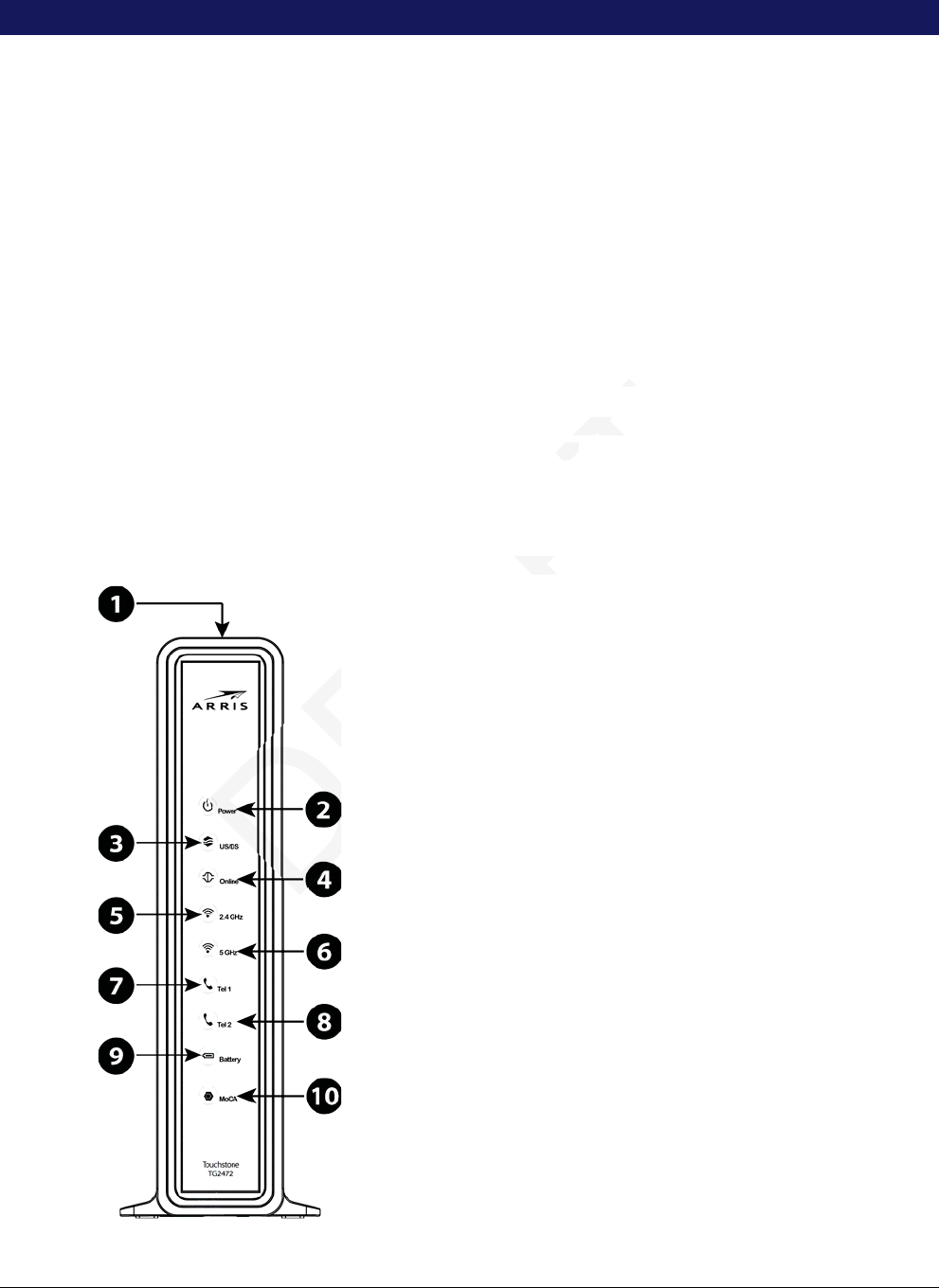
Chapter 7
Using the Telephony Gateway
This chapter describes the controls and features available on the Telephony Gateway, and covers
basic troubleshooting procedures.
Setting upYour Computer to Use the Telephony Gateway (page 32)
Indicator Lights for the TG2472 (page 32)
Using the Reset Button (page 35)
Setting up Your Computer to Use the Telephony Gateway
Follow the instructions in the information packet supplied by your cable company. Contact your
cable company if you need help setting up your computer.
Indicator Lights for the TG2472
The Telephony Gateway has LED indicator lights to assist in troubleshooting.
Release 24 DRAFT 1.0 November 2014 Touchstone TG2472 Telephony Gateway User Guide 33
DRAFT
GaGa
ed by your cabled by yo
uter.ter.
tor lights to assist in troutor lights to ass
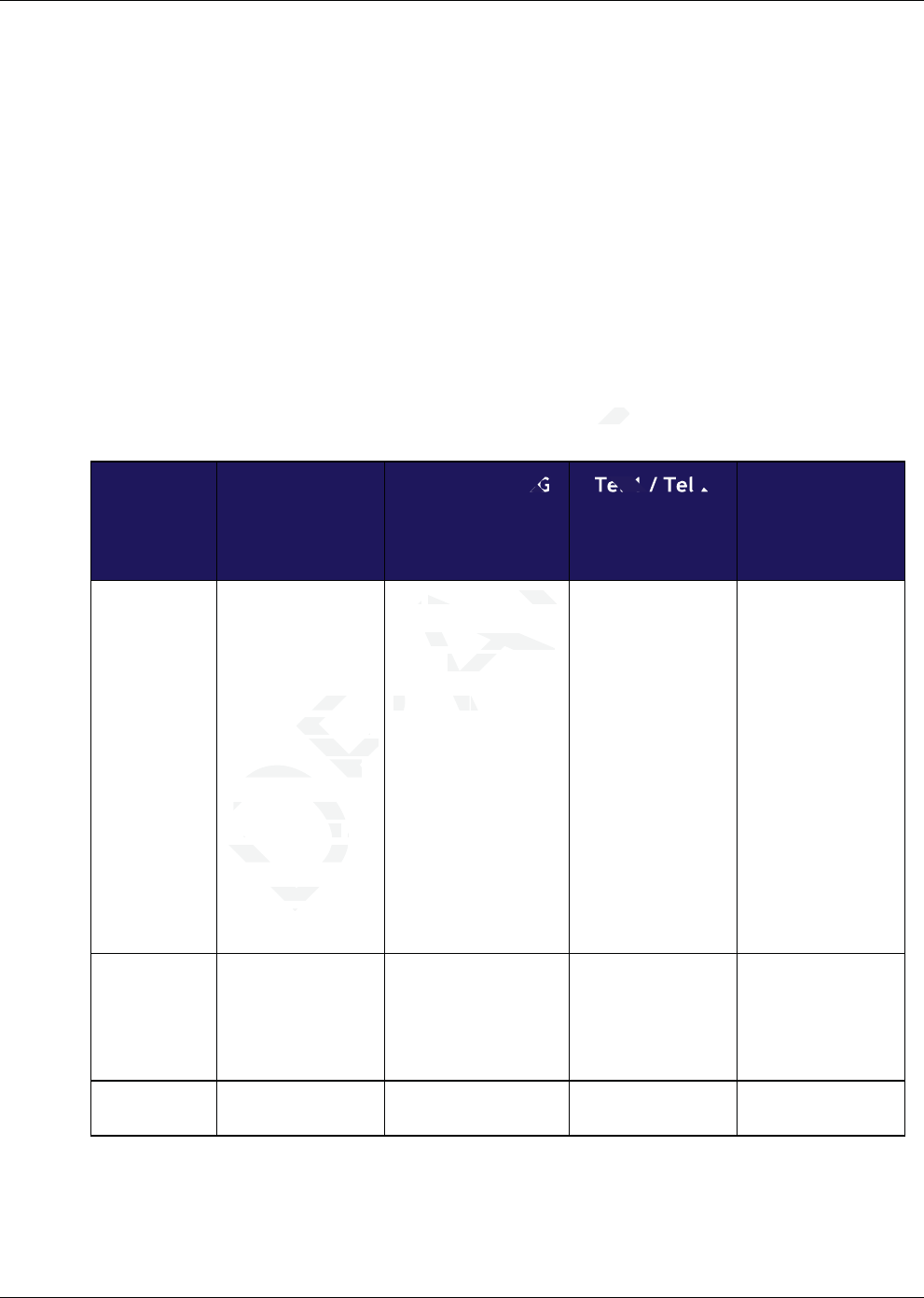
Chapter 7: Using the Telephony Gateway
1. WPS Button/LED
2. Power
3. US/DS
4. Online
5. 2.4 GHz WiFi
6. 5 GHz Wi-Fi
7. Tel 1
8. Tel 2
9. Battery
10. MoCA
Wiring Problems
If the Telephony Gateway begins flashing all its lights for more than 10 seconds, this indicates a
problem with the telephone wiring — the red and green wires may be shorted (touching), or there
may be undesired voltage on the lines. If this pattern persists for more than 10 seconds, disconnect
the telephone lines from the Telephony Gateway, then call a wiring technician for assistance.
Patterns: Normal Operation (LAN and Telephone)
The following table shows light patterns for the Ethernet, MoCA and wireless LANs, and the
telephones, during normal operation.
Mode Ethernet
(LEDs on rear
panel
connector)
2.4G Wi-Fi / 5G
Wi-Fi
Tel 1 / Tel 2 MoCA
AC Power Green LED On =
Computer with
1Gbps port
connected
Amber LED On
= Computer with
100 Mbps/10Mbps
port connected
Amber/Green
LED Flash =
Computer activity
Both LEDs Off =
Computer not
connected
On = Wi-Fi enabled
Flash = Computer
activity
Off = Wi-Fi disabled
On = On-hook
Flash = Off-hook
Off = disabled
On = MoCA
enabled
Flash = MoCA
network device
activity/traffic
Off = MoCA
disabled
No AC Power Off Off On = On-hook
Flash = Off-hook
Off = disabled
Off
Firmware
Upgrade
(normal
operation)
(normal operation) (normal
operation)
(normal
operation)
Patterns: Normal Operation (WAN and Battery)
The following table shows light patterns during normal operation.
Release 24 DRAFT 1.0 November 2014 Touchstone TG2472 Telephony Gateway User Guide 34
DRA
ED OnED O
puter with uter with
Mbps/10Mbps /10Mbps
port connectedport connected
Amber/Green Amber/Gree
LED FlashLED Flash
= =
Computer activitComputer activ
LEDsLEDs
D
D
RAFT
CA anCA a
AFT
FT
5G
FT
FT
FT
el 1
T
T
T
FT
nn
= Wi= W
-
Fi enabledabled
Flashash
= Computer Computer
activityactivit
Off = Wi-Off = Wi-
Fi disF
F
On
AF
F
F
RA
F
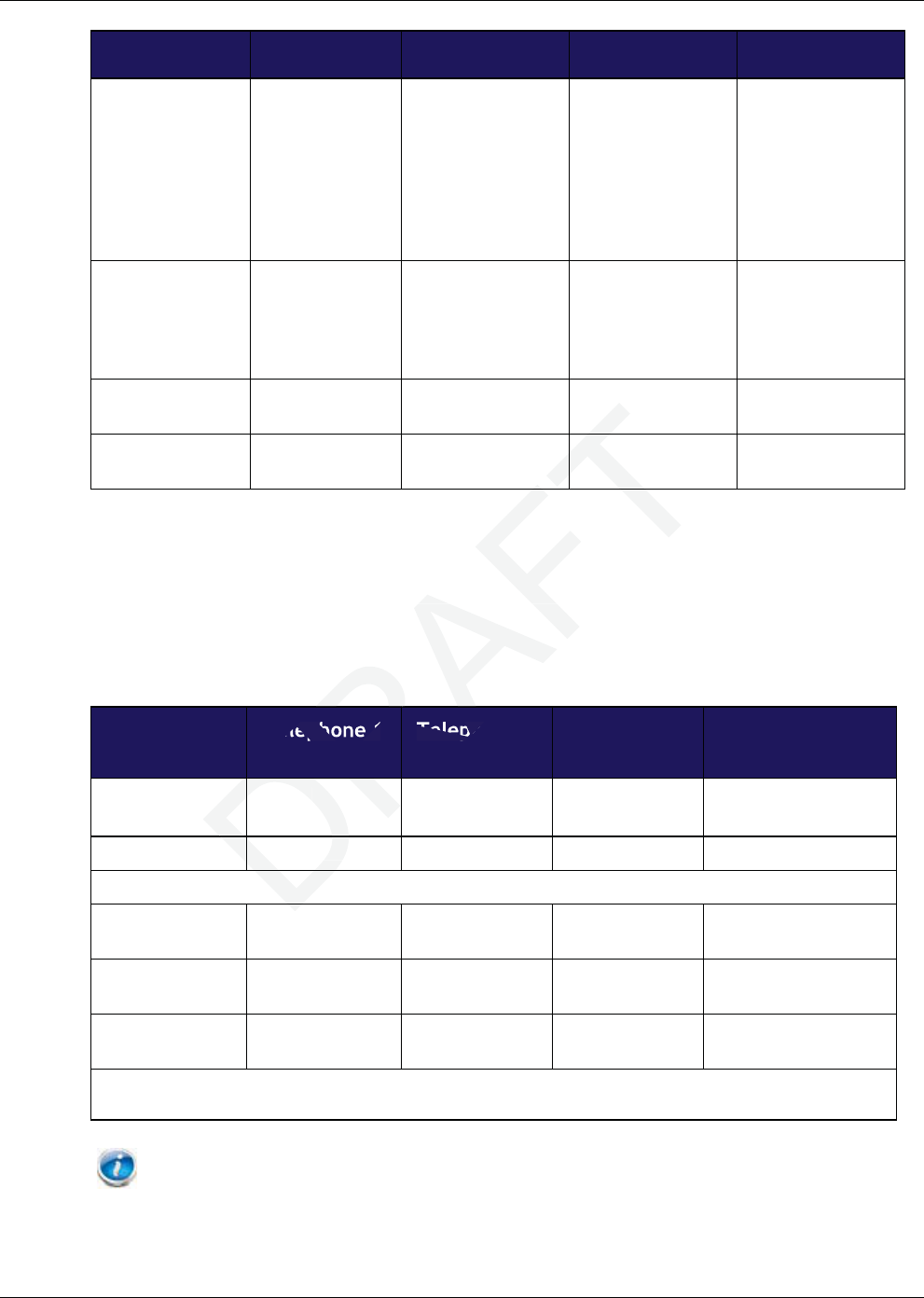
Chapter 7: Using the Telephony Gateway
Mode Power US/DS Online Battery
AC Power Good On On = Connected
to the Internet
Flash = Not
connected to the
Internet
On = Internet
available
Off = Internet not
available
On = Battery good
or low
Off = Battery
missing
Flash = Battery
bad
No AC Power,
Battery Installed
Flash Off Off Off = Battery
power
Flash = Battery
bad
No AC Power,
No Battery
Off Off Off Off
Firmware
Upgrade
On Flash On (normal
operation)
Patterns: Startup Sequence
The following tables show the Telephony Gateway light patterns during each phase of the startup
sequence. There are two phases of startup; the telephony phase and the cable modem phase. Both
are outlined below.
Telephony Startup Sequence
Power, US/DS,
Online
Telephone 1 Telephone 2 Battery Description
Off Off Off Off No power to modem
Flash Flash Flash Flash Power-on Self Test
See "Cable Modem Startup Sequence
On Flash Off Off Retrieving telephone
network information
On Off Flash Off Retrieving telephone
line information
On Flash Flash Off Activating telephone
service
Normal Operation
Note: The US/DS indicator flashes during startup, and turns on when the Telephony
Gateway establishes a connection.
Release 24 DRAFT 1.0 November 2014 Touchstone TG2472 Telephony Gateway User Guide 35
On
T
FT
FT
FT
FT
y Gateway light patterns y Gateway light
artup; the telephony phastup; the telephony p
D
DRA
DRA
ephone 1
RA
RA
Teleph
RA
RA
RA
D
RA
OffOff
D
D
DR
R
R
D
R
Flashash
D
D
D
D
D
D
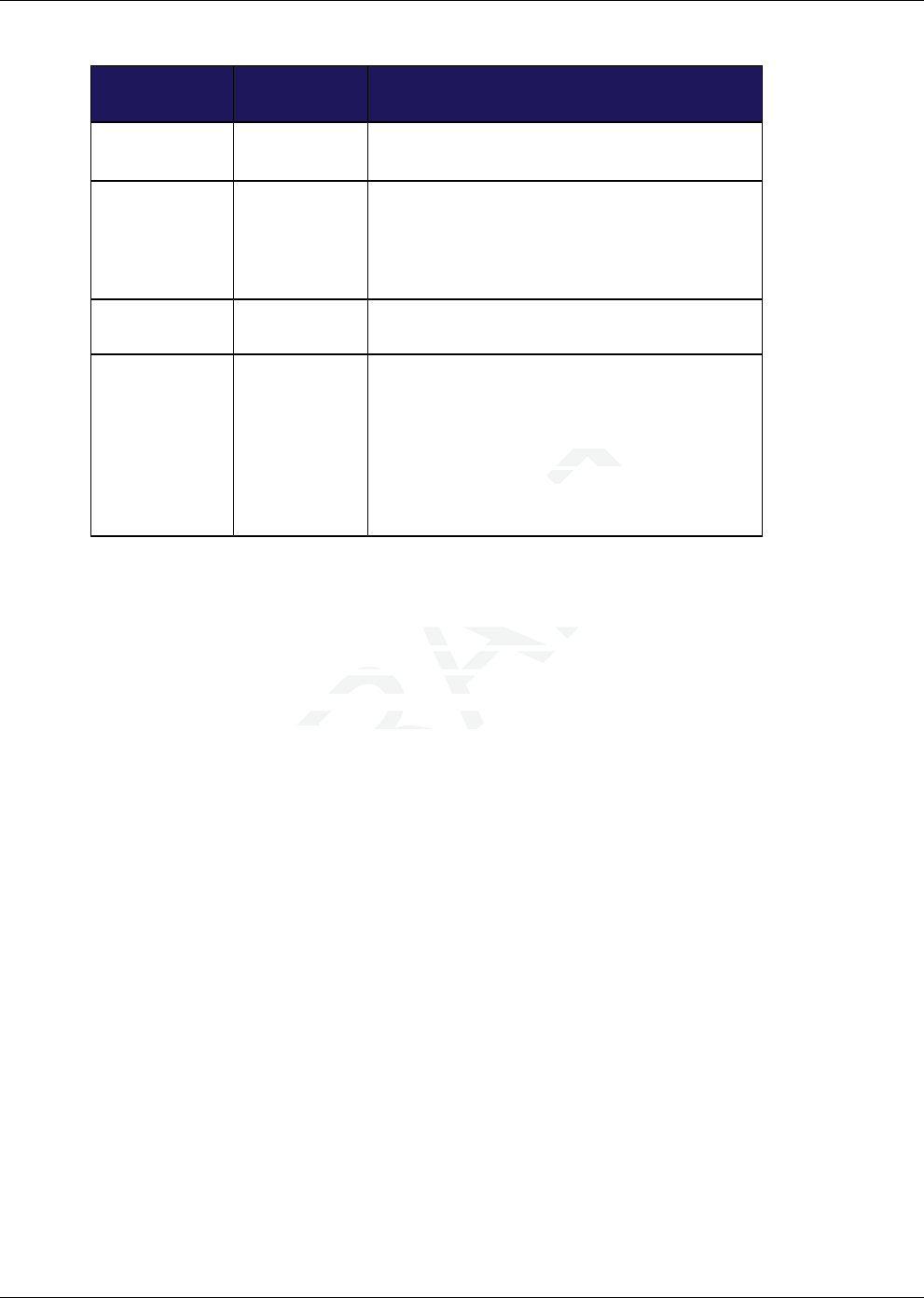
Chapter 7: Using the Telephony Gateway
Cable Modem Startup Sequence
US/DS Online Description
Slow Flash
(1/second)
Off Downstream acquisition in progress
On
(until
Upstream
acquisition
starts)
Off Downstream acquisition completed
Fast Flash
(3/second)
Off Upstream acquisition in progress
On
Slow Flash
(during
acquisition)
On (when
modem IP
address
obtained)
Upstream acquisition completed, ready for
service
Using the Reset Button
Use the Reset button (1), on the back of the Telephony Gateway, to reset the modem and perform
initialization as if you power cycled the unit. You may need to reset the Telephony Gateway if you are
having problems connecting to the Internet. Using this button will be rare.
Use a pointed non-metallic object to press this button. The Reset button is recessed to prevent
accidental resets.
Release 24 DRAFT 1.0 November 2014 Touchstone TG2472 Telephony Gateway User Guide 36
DRAFT
n completed, re
n compl
serviceervi
FT
back of the Telephony Gatf the Telephony Gat
cled the unit. You may necled the unit. You may ne
g to the Internet. Using tg to the Internet. U
h
allicallic
object to press this ect to press thi
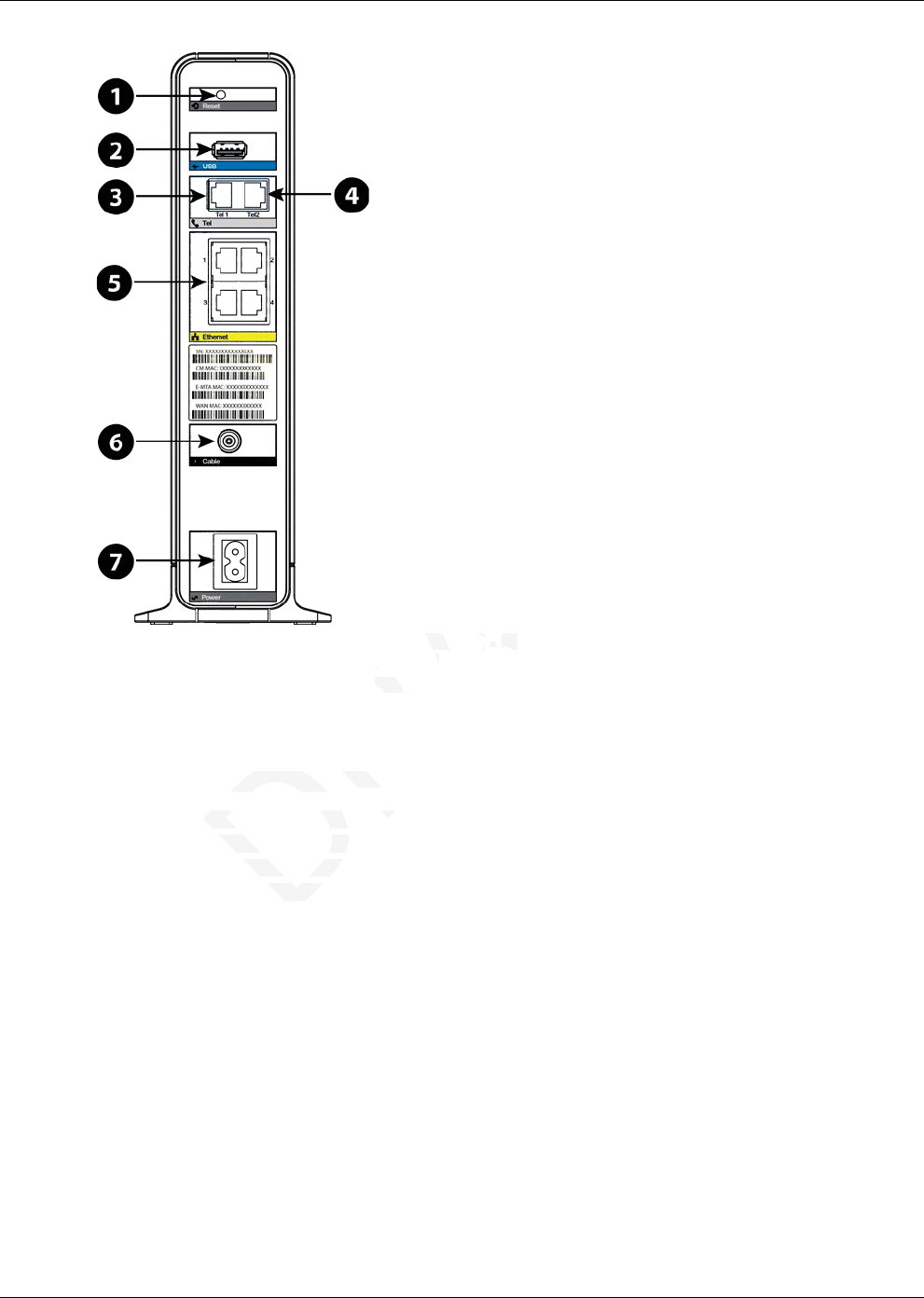
Chapter 7: Using the Telephony Gateway
1. Reset button
2. USB
3. Tel 1
4. Tel 2
5. Ethernet (1 - 4)
6. Cable
7. Power
Resetting the Router to Factory Defaults
To reset the router to factory defaults, press and hold the Reset button (1) on the back of the
Telephony Gateway for more than fifteen seconds. This restores the wireless setup configuration and
router configuration parameters to the factory defaults. You may need to do this if a
misconfiguration has locked out all access.
Booting from Battery
The TG2472 supports a “Boot from Battery” feature that allows the Telephony Gateway to provide
continued telephone service during power outages.
To start the TG2472 from its battery, follow these steps:
1. If a battery is already installed in the Telephony Gateway, remove it.
2. Re-insert the battery into the Telephony Gateway (see Battery Installation and Removal (page
16) for details).
3. Press the Reset button (1); the Power light should turn on immediately.
Release 24 DRAFT 1.0 November 2014 Touchstone TG2472 Telephony Gateway User Guide 37
DRAFT
5. Ethernet (1 ernet (1
- -
4)4)
6. Cable6. Cable
7. Power7. P
to Factoryto Factory
DefaultsDefa
router to factory defaults
router to factory defaults
eway for more thaneway for more th
on parameteron paramete
s lockeds locked

Chapter 8
Troubleshooting
The Telephony Gateway is plugged in, but the Power light is Off
Check all power connections. Is the power cord plugged in firmly at both ends?
If you plugged the power cord into a power strip, make sure the strip is switched on.
Avoid using an outlet controlled by a wall switch, if possible.
Finally, check the fuse or circuit breaker panel.
I'm not getting on the Internet (all connections)
It may take over 30 minutes to establish a connection the first time you power up your Telephony
Gateway, especially when many people are online. Always leave your Telephony Gateway plugged
into AC power and connected to the cable system.
Check the front panel lights:
The Power and Online lights should be on.
If the Power light blinks for more than 30 minutes, call your cable company for assistance.
Check your cable connections. Connectors should be tight. The coax cable should not be pinched,
kinked, or bent sharply—any of these can cause a break or short in the cable (you may have to replace
the cable). If you have one or more splitters between the Telephony Gateway and CATV outlet,
remove the splitters and connect the Telephony Gateway directly to the outlet.
Proceed to the Ethernet or wireless solutions if necessary.
I'm not getting on the Internet (Ethernet)
If you are using a hub, is the hub turned on?
Are you using the right type of Ethernet cable? Use the supplied cable for direct connection to a
computer; use a cross-over cable for connection to a hub.
Press the Reset button on the back of the Telephony Gateway.
A misconfiguration could lock out all access to the Telephony Gateway router. If you think this has
happened, see Resetting the Router to Factory Defaults (page 36).
I'm not getting on the Internet (Wireless)
Check the indicator lights, see Using the Telephony Gateway (page 32) — the Wi-Fi light should be
on.
Does your connection utility discover your wireless LAN? If you turned off “Broadcast SSID” you
need to manually enter the name of your wireless LAN in the connection utility.
Release 24 DRAFT 1.0 November 2014 Touchstone TG2472 Telephony Gateway User Guide 38
DRAFT
s)s)
n the first time you pow
n the first time y
e. Always leave your Telep
e. Always leave your Te
em.em.
ould be on.ould be o
more than 30 minutes, cahan 30 minutes, ca
s. Connectors should be ts. Connectors shou
any of these can cause a brany of these can cause
one or more splitters betwne or more splitters bet
and connect the Telephoonnect the Telepho
Ethernet or wireless solutEthernet or wireless s
the Internetthe Intern
b, is thb, is th

Chapter 8: Troubleshooting
Change your security mode to “disabled”. Enable one of the other security modes as soon as you find
the problem.
A misconfiguration could lock out all access to the Telephony Gateway router. If you think this has
happened, see Resetting the Router to Factory Defaults (page 36).
My wireless Internet connection stops working sometimes
This is usually caused by interference. Two common sources are 2.4GHz “remote” telephones and
microwave ovens. If you cannot remove the interfering product, try using a different channel or
setting Protected Mode.
I can get on the Internet, but everything is slow
If the Web site you are visiting is very popular, that site may be having trouble servicing all the
requests. If other sites download quickly, wait for a few minutes and try again. Usage during peak
hours may also affect the connection speed.
Other communications on the LAN, or interference with wireless connections, may slow down your
connection.
I don't have a dial tone when I pick up the phone - why?
In order for telephone service to be functional on the Telephony Gateway, telephone service must
have been purchased from the service provider and configured on your Telephony Gateway. The
following steps should help in identifying the source of the problem.
1. Is the Power LED lit?
x If not, check to make sure the Telephony Gateway is plugged in and the outlet has power.
x If the LED is lit, go to the next step.
2. Is the Online LED lit?
x If not, check the coax connection at the Telephony Gateway and the wall. Ensure they are
connected and tight. If they are and you do not have dial tone, contact your service provider.
x If the Online LED is lit, go to the next step.
3. Is the Telephone (Tel 1 or Tel 2) LED lit?
x If not, phone service has not been set up on that line. Contact your service provider.
x If it is blinking, there is a phone off hook somewhere in the house. Find that phone and hang
it up.
x If it is lit, go to the next step.
4. Is the phone plugged directly into the Telephony Gateway?
x Make sure the phone is plugged into the port on the back of the Telephony Gateway labeled
“Tel 1” for line 1, and “Tel 2” for line 2.
x If so, try a different phone. Make sure the new phone is a working phone.
x If a known good phone is used and you still don’t have dial tone, try a different phone cable.
If a new phone and cable do not restore dial tone, call your service provider.
5. Is the Telephony Gateway plugged into a wall outlet?
Release 24 DRAFT 1.0 November 2014 Touchstone TG2472 Telephony Gateway User Guide 39
DRAFT
e he h
utes andutes a
with wireless connectio
with wireless co
up thh
e phone e pho
-
w
functional on the Telephoctional on the Telep
ervice provider and configrovider and config
n identifying the sourcn identifying the so
e off
to make sure the Telephomake sure the Telepho
D is lit, go to the next stepD is lit, go to the
line LED lit?line L
check the coax conncheck the coax c
d and tight. If d and tight. If
e LED is e LED is

Chapter 8: Troubleshooting
x If so, unplug the phone connector at the back of the Telephony Gateway and plug in a known
working phone. If you now have dial tone, the problem is with the house wiring. Contact
your cable company or a qualified wiring technician to correct the house wiring. If you still
do not have dial tone, contact your service provider.
Release 24 DRAFT 1.0 November 2014 Touchstone TG2472 Telephony Gateway User Guide 40
DRAFT

Glossary
A
Amp-Hour
A measure of battery capacity. For example, a
1.0Ah battery can nominally supply one
Ampere of current for one hour.
C
Category 5e (Cat5e)
A high-quality type of cable, used for gigabit
Ethernet (1000BaseT) connections. When
purchasing Ethernet cables, always look for
Category 5e cable.
Coaxial cable (coax)
A thin wire, used to connect your television
and Telephony Gateway to the cable TV
system. You can buy coax from any
electronics retailer and many discount stores.
CPE
Customer Premise Equipment. This is the
equipment that is plugged in to the Telephony
Gateway; typically a computer or hub.
Cross-over
An Ethernet cable used to connect two hubs
(or a hub and a cable modem) together. Also,
some Ethernet hubs may have built-in
cross-over on one or more ports (which
eliminates the need for a cross-over cable).
D
DHCP
Dynamic Host Configuration Protocol. An IP
protocol used to provide an IP address and
location of services (such as DNS and TFTP)
needed by a device connecting to the network.
DHCP allows the cable company to configure
your computer’s networking software for you.
DNS
Domain Name Service (Server). An IP service
that associates a domain name (such as
www.example.com) with an IP address.
DOCSIS
Data Over Cable System Interface
Specification. The interoperability standards
used for data communications equipment on
an HFC network.
Downstream
In an HFC network, the direction from the
head-end to the subscriber. Some older cable
documentation may refer to this as the
forward path.
E
EMTA
Embedded Multimedia Terminal Adapter. An
MTA device that is integrated with a cable
modem.
Ethernet
A standard method of connecting two or more
computers into a Local Area Network (LAN).
EuroDOCSIS
The European version of DOCSIS.
Event
An informational message used for
monitoring network status.
F
F-connector
The type of connector used on coax cable.
There are two common types of F-connector,
slip-on and screw-on. Use coax with screw-on
connectors for connecting your Telephony
Gateway.
Firewall
A hardware or software device that prevents
unauthorized access to a private network from
the Internet. The TG2472 provides a built-in
firewall.
Release 24 DRAFT 1.0 November 2014 Touchstone TG2472 Telephony Gateway User Guide 41
DRAFT
stores.store
nt. This is the nt. This i
in to the Telephony in to the Telephony
mputer or hub.mputer or hub.
cable used to connect twocable used to connect tw
d a cable modem) togetd a cable modem) t
hubs may have buhubs may have
or more poor more po
r a cr a c
edded Muedded
MTA device that MTA devi
modem.modem.
Ethernet
A standarA st
d me
computers c
EuroDEuro
TT

G
Gateway
The device, usually a router, that connects
devices on a given IP subnet to other IP
subnets.
H
Headend
The “central office” in an HFC network. The
headend houses both video and data
equipment. In larger cable networks, a
“master” headend often feeds several
“remote” headends to provide distributed
services.
HTTP
HyperText Transfer Protocol.
Hub
A box with several Ethernet connectors.
Ethernet hubs provide a common point of
contact for all connected devices.
I
IP address
A number assigned to your computer by your
cable company, used to identify your
computer to other systems on the Internet.
ISDN
Integrated Services Digital Network. A digital
telephony standard that provides
communication speeds about twice as fast as
standard dialup.
L
LAN
Local Area Network. A network that allows
computers in a single location (such as a
building) to communicate with one another.
LED
Light Emitting Diode. A semi-conductor
diode that emits light when current is passed
through it.
M
MAC address
A number that uniquely identifies any device
connected to a network. Your cable company
uses your Telephony Gateway’s MAC address
to authorize access to the Internet. The MAC
address is printed on a label on the bottom of
your Telephony Gateway.
P
Protocol
A set of rules and formats that determines the
communication behavior of network entities
at a given layer.
Proxy
A device or program that stands in between a
server (for example, a web site) and a client
(your browser), providing a way to relieve
some of the burden from the server. For
example, your cable company may have a web
proxy that keeps copies of popular web pages;
the proxy can send you those pages instead of
fetching them directly from the web site,
resulting in faster page loading and less
network congestion.
R
RF
Abbreviation for Radio Frequency. Some
literature refers to coax as “RF cable” and the
connectors as “RF connectors.”
RJ-11
A standard 2-conductor modular connector,
commonly used in North America for
connecting telephones.
RJ-45
A standard 8-conductor modular connector,
commonly used on Ethernet cable. An RJ-45
connector looks like a wide RJ-11 (telephone)
connector.
Release 24 DRAFT 1.0 November 2014 Touchstone TG2472 Telephony Gateway User Guide 42
DRAFT
nt of t of
to your computer by yourr computer by your
used to identify your used to identify you
other systems on the Interother systems on the Int
Digital NDigital N
at pat p
ven layven l
ProxyProxy
A device or program
A device or pro
server (for exampl
ver (for examp
(your browser),(your
some of the bso
example, ex
proxy tprox
the the
ff

S
Splitter
A small box with three cable connectors: one
input and two outputs. You may need a
splitter if you have a TV already connected to
the cable outlet that you want to use for your
Telephony Gateway. You can buy a splitter
from any electronics retailer and most
discount stores.
SSID
Service Set IDentifier. A string of text (up to
32 characters long) that uniquely identifies a
wireless LAN.
Switched outlet
A power outlet that may be turned on and off
using a wall switch. Usually intended for
lamps. Avoid plugging your computer or
Telephony Gateway into a switched outlet to
avoid disruptions.
T
TCP/IP
Transmission Control Protocol/Internet
Protocol. The protocols used to facilitate
communications across one or more
connected networks.
TDMA
Time Division Multiple Access. A method
used by DOCSIS-compliant cable modems for
sending upstream data with minimal
interference.
U
Upstream
The path from a subscriber device to the
headend. Some older cable documentation
may refer to this as the return path or reverse
path.
W
WEP
Wired Equivalent Privacy. A common
standard for encrypting data sent over a
wireless LAN.
WPA
Wi-fi Protected Access. A standard for
encrypting data sent over a wireless LAN.
WPA offers improved security over WEP.
Release 24 DRAFT 1.0 November 2014 Touchstone TG2472 Telephony Gateway User Guide 43
DRAFT
tocol/Internet tocol/Intern
s used to facilitate used to facilitate
oss one or more ne or more
rks.rks.
Multiple Access. AMultiple Access.
ompliant compliant c
a wita wit
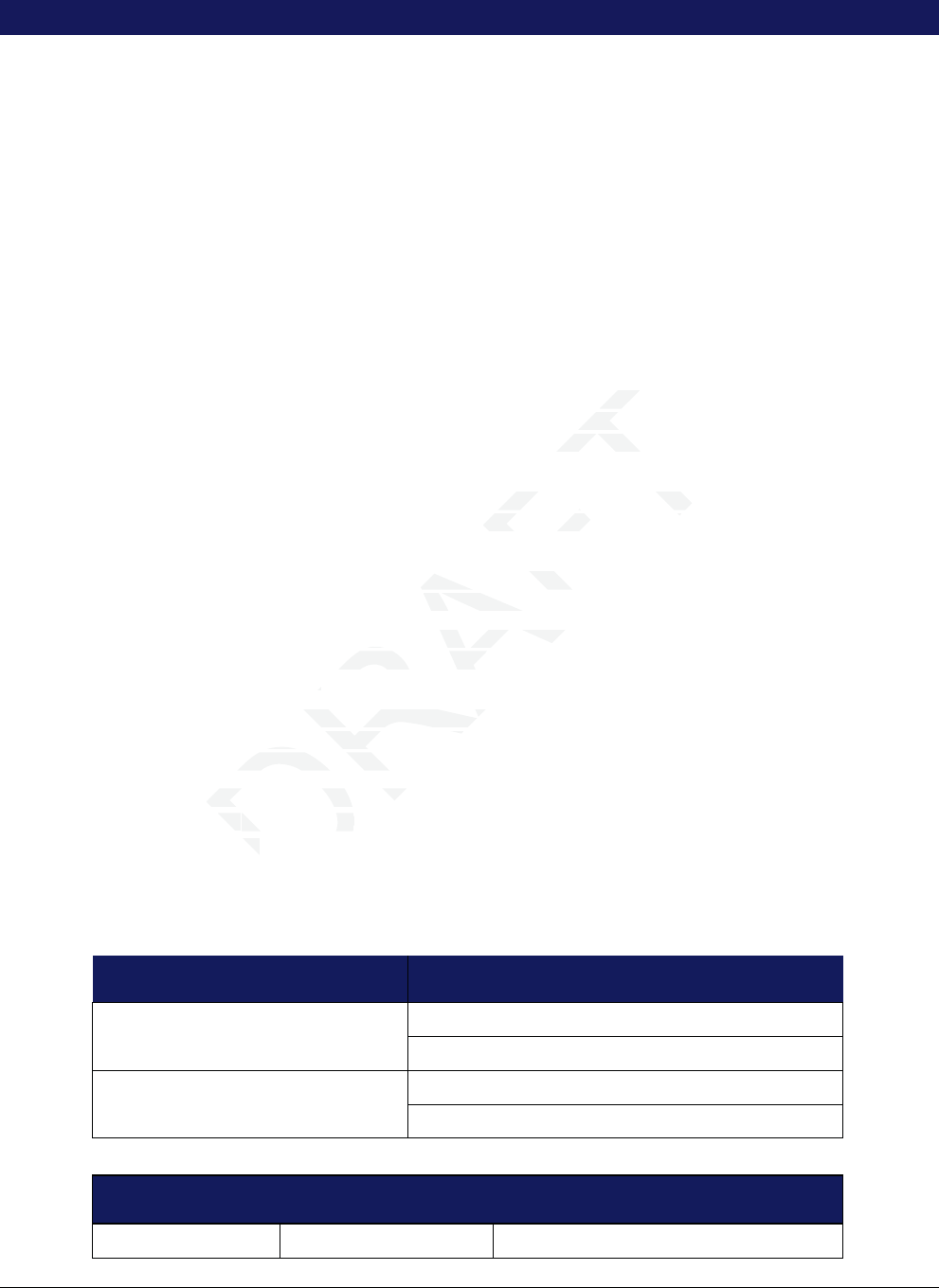
Chapter 9
ARRIS Contacts
ARRIS offers broadband service providers a complete, integrated, application-oriented IP suite of
back-office automation tools for network content, subscriber, and workforce management as well as
advanced advertising and on demand services.
Before You Call ARRIS Support
When working with Technical Support, you can help us to expedite your call by following these
guidelines:
Please be prepared to give your Technical Support Contract ID number whenever you contact
ARRIS Technical Support. If you do not know your Technical Support Contract ID number or
have questions about a support contract, please contact ARRIS Technical Services at
services.orders@arrisi.com or (678) 473-8302.
Be prepared to provide your name, company name, site location, serial number of the system
you are calling about (if applicable), system and software version numbers, and as much detail
about the problem as possible.
Review available documentation, including release notes, product and installation manuals, and
online help for information about your problem.
Do not reboot or restart equipment or software processes prior to consulting with ARRIS
Technical Support—vital data that could assist in resolving the problem can be lost when these
actions are performed.
All personnel who call Technical Support should have a high level of familiarity with the ARRIS
system, including knowing the system passwords. We strongly recommend that you have
personnel trained through ARRIS Educational Services programs.
ARRIS Technical Support supports ARRIS-supplied products only. Issues related to other hardware,
software, or non-ARRIS networks must be addressed by your organization or the appropriate
third-party vendor.
By Telephone
North America Region
Legacy ARRIS +1 888 221 9797 (North America)
+1 678 473 5656 (Worldwide)
Legacy Motorola Home + 1 888 944 4357 (North America)
+1 215 323 2345 (Worldwide)
Latin America Region:
Argentina: Legacy Motorola Home 0 800 666 3601
Release 24 DRAFT 1.0 November 2014 Touchstone TG2472 Telephony Gateway User Guide 44
DRAFT
ract ID nract I
echnical Suppechnic
ntact ARRIS Techn
ntact ARRI
y name, site location, seri
y name, site location, se
em and software version nm and software version n
ncluding release notes, pncluding release no
ut your problem. your problem
uipment or software procipment or software proc
data that could assist in data that could as
. .
o call Technical Support sall Technical Support s
ng knowing the system png knowing the system p
ained through ARRIS Eduained through ARR
nical Support supports A
nical Support supports A
on-on-
ARRIS networks ARRIS netwo
or. or.
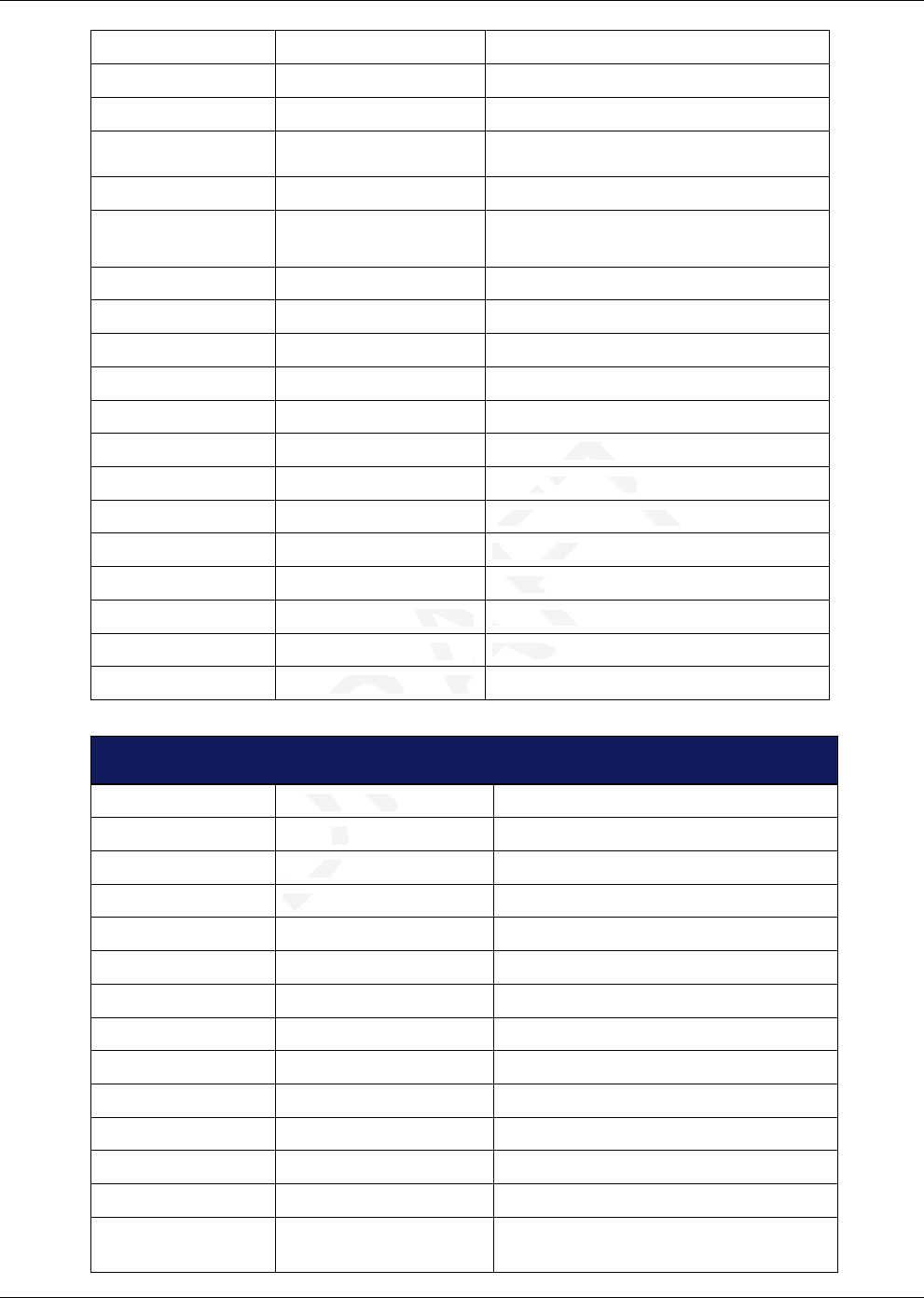
Chapter 9: ARRIS Contacts
Aruba: Legacy Motorola Home 215 323 2346
Bolivia: Legacy Motorola Home 800 100 694
Brazil: Legacy Motorola Home 0 800 891 5314
Legacy ARRIS +55 11 2737 7629
Chile: Legacy Motorola Home 1230 020 5564
Legacy ARRIS +56 2 678 4500
Colombia: Legacy Motorola Home 1 8005 1 80947
Legacy ARRIS +57 1 381 9103
Costa Rica: Legacy Motorola Home 215 323 2346
Ecuador: Legacy Motorola Home 215 323 2346
El Salvador: Legacy Motorola Home 800 6625
Honduras: Legacy Motorola Home 800 0123, then 866 842 0264
Mexico: Legacy Motorola Home 001 866 391 2349
Legacy ARRIS 01 800 522 7747 or +52 55 22828531
Panama: Legacy Motorola Home 001 800 203 4345
Peru: Legacy Motorola Home 0 800 5 3651
Puerto Rico: Legacy Motorola Home 866 862 2627
Rep. Dominicana: Legacy Motorola Home 1 888 751 8898
Venezuela: Legacy Motorola Home 0 800 100 9161
Europe Region:
Europe: Legacy ARRIS +31 20 311 2525
Belgium: Legacy Motorola Home 0 800 72 163
Denmark: Legacy Motorola Home 80 88 6748
Finland: Legacy Motorola Home 0 800 114 263
France: Legacy Motorola Home 0 800 90 7038
Germany: Legacy Motorola Home 0 800 18 73019
Hungary: Legacy Motorola Home 06 800 18164
Ireland: Legacy Motorola Home 1 800 55 9871
Israel Golden Lines: Legacy Motorola Home 1 809 25 2071
Israel Bezeq: Legacy Motorola Home 1 809 42 9181
Israel Barak: Legacy Motorola Home 1 809 31 5435
Italy: Legacy Motorola Home 800 788 304
Luxembourg: Legacy Motorola Home 0 800 2 5310
Netherlands -
Holland:
Legacy Motorola Home 0 800 022 0176
Release 24 DRAFT 1.0 November 2014 Touchstone TG2472 Telephony Gateway User Guide 45
DRAFT
3, then 866 843, then
T
866 391 2349866 391 2349
T
01 800 522 7747 or +52 5
01 800 522 7747 or +52
FT
me
001 800 203 4345001 800 20
FT
AF
Home
0 800 5 3651800 5
AF
AF
AFT
AF
ola Homea Home
866 862 2627866 862 26
AF
AF
AF
AF
otorola HomeHome
1 888 7511 888 75
AF
AF
AF
AF
cy Motorola Homecy Motorola Home
0 80
RA
A
A
RA
A
A
A
DR
R
Legacy ARRISgacy ARRIS
D
D
DR
D
Legacy Motoy M
D
D
DR
D
Legacy MLegacy
D
D
D
D
LegaLega
D
D
D
D
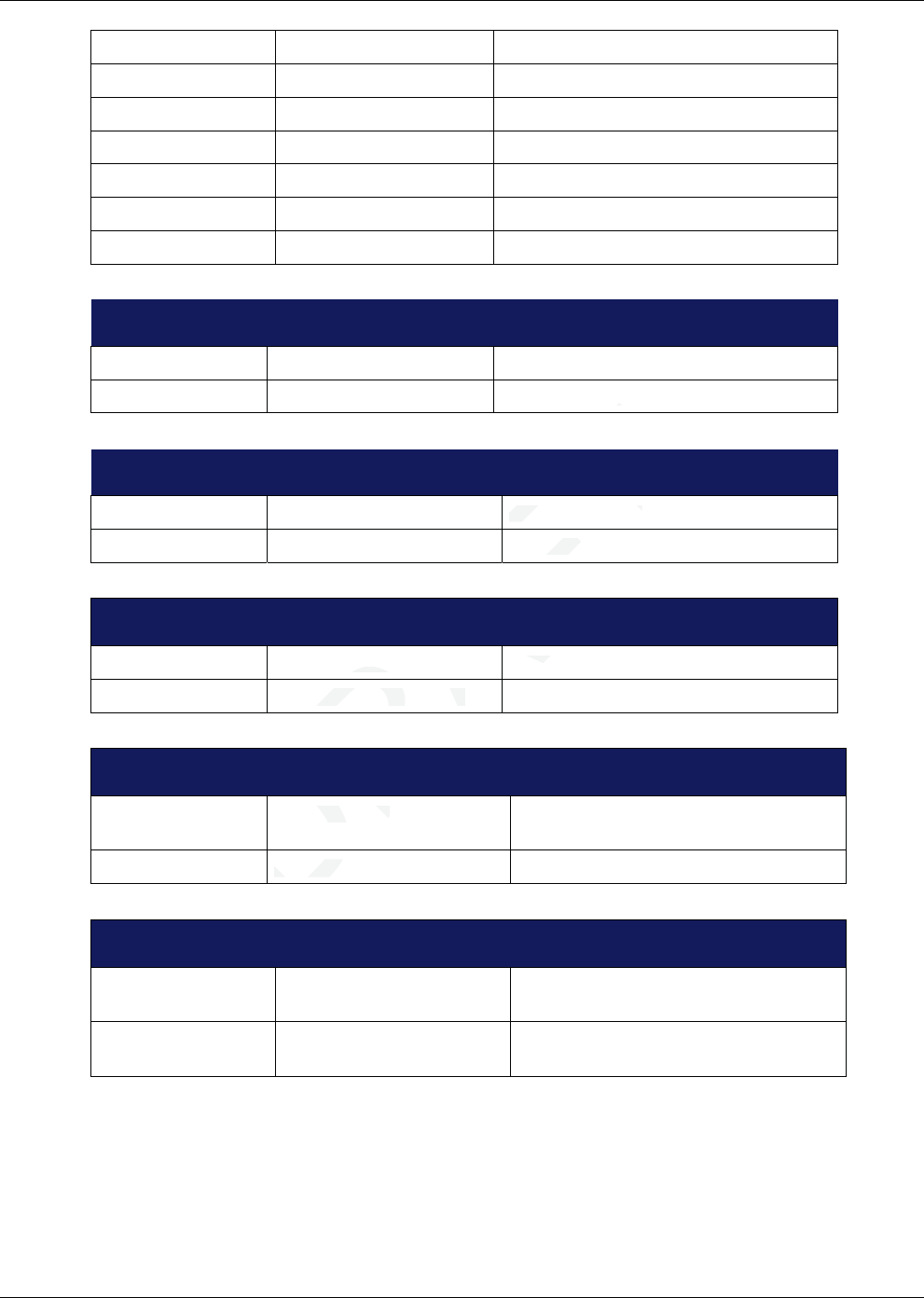
Chapter 9: ARRIS Contacts
Norway: Legacy Motorola Home 800 15 670
Poland: Legacy Motorola Home 00 800 111 3671
Portugal: Legacy Motorola Home 800 81 3461
Spain: Legacy Motorola Home 900 99 1771
Sweden: Legacy Motorola Home 020 79 0241
Switzerland: Legacy Motorola Home 0 800 561 872
United Kingdom: Legacy Motorola Home 0 800 404 8439
Asia Region:
Asia Legacy ARRIS +86 755 8634 9110
Legacy Motorola Home +1 847 725 4011 (Worldwide)
Japan Region:
Japan: Legacy ARRIS +81 3 5461 7320
Legacy Motorola Home +1 847 725 4011 (Worldwide)
Korea Region:
Korea: Legacy ARRIS +82 31 740 4203
Legacy Motorola Home +1 847 725 4011 (Worldwide)
China Region:
China: Legacy ARRIS +86 755 8634 9110 or 4008810685 (in
China only)
Legacy Motorola Home +1 847 725 4011 (Worldwide)
Australia / New Zealand Region:
Australia /
New Zealand
Legacy ARRIS +86 755 8634 9110
Legacy Motorola Home 61 3 81997220 or 1800 242664
(Australia only)
By Email
Release 24 DRAFT 1.0 November 2014 Touchstone TG2472 Telephony Gateway User Guide 46
DRAFT
T
FT
+81 3 5461 7320+81 3 5461 7320
FT
F
+1 847 725 4011 (W47 72
F
F
FT
AF
AF
AF
AFT
RAF
AF
RRISRRIS
+82 382 3
RA
A
A
A
cy Motorola Home cy Motorola Home
+
RA
A
A
RA
A
DR
DR
Legacy ARRIScy ARRIS
D
D
DR
D
Legacy MLegacy M
D
D
D
D
D
D
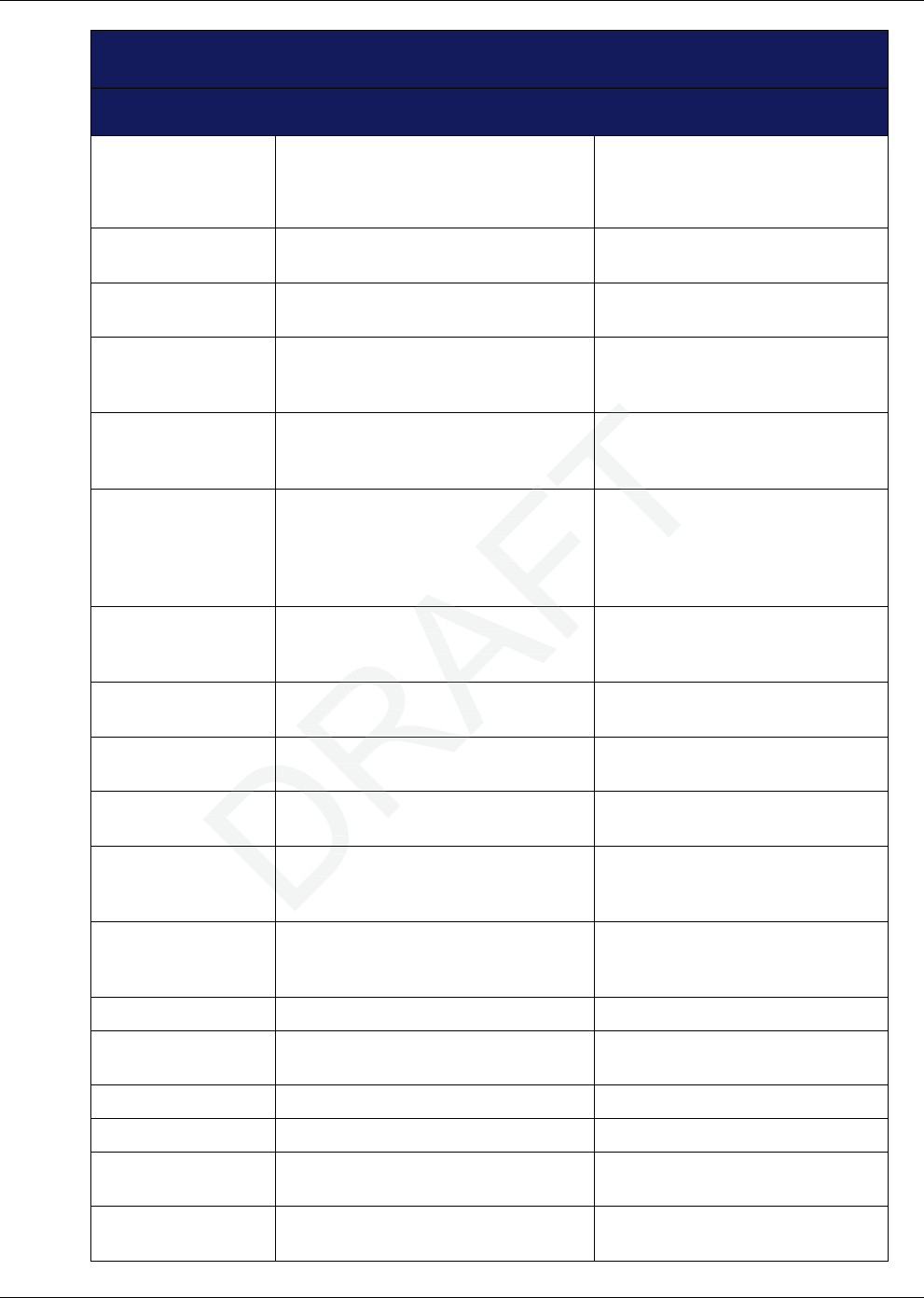
Chapter 9: ARRIS Contacts
North America:
Headend and Network Equipment:
RF Optics: Ruckus, Optics, Amps, Nodes,
Transmitters, CHP, Passives,
OptiMax, CoreWave, CoreView
RFOptics-support@arrisi.com
CMTS Products: C3, C4, ICO, ASA, CxM, CMTS1000,
CMTS1500, E6000
techsupport.na@arrisi.com
CMTS Product: BSR, SRM4, HSIM4, TX32, RX48,
SRM10G
tac.helpdesk@arrisi.com
Moxi and WHS
Products:
Moxi, MCR, Portal, WHS, WHS5225,
MediaPlayer, Whole Home Solution,
Gateway
techsupport.na@arrisi.com
D5 and DVS
Products:
D5, Application Manager, VIPr,
Hemi, Encore, Quartet, Prelude, EGT
or DVS
techsupport.na@arrisi.com
DVS Products: CAS, DACs, CASMR, APEX3000,
NC2000, DreamGallery, Secure
Media, VideoFlow, AVP100, STBs,
AS-RAC, QT Plus, CherryPicker,
Encoder, Astria
tac.helpdesk@arrisi.com
EMP Products: AdEdge, APS, BEQ6XXX, BME50,
BMR1200, CVEx, MSP2XXX, RMS,
SBSS, SVA, VMS
emp-support@arrisi.com
Digital Ad Insertion: Ad Insertion, Skyvision, Spots, ACM,
n5, XMS
ai-support@arrisi.com
Video on Demand: Video OnDemand, VOD, nABLE,
CMM, n5, XMS, Transit
vod-support@arrisi.com
VOD Products: B1 Video Server, M3 Video Server,
cDVR Video Solution
tac.helpdesk@arrisi.com
WorkAssure: WorkAssure, I&R, SageQuest,
Wireless Matrix, Tech Director, Tech
Calendar, SSM Alarms
workassure-support@arrisi.com
Assurance Products: ServAssure, OpsLogic, Powersense,
SALIVE, EventAssure, HouseCheck,
Data Warehouse, Starnodes
assurance-support@arrisi.com
GPON Product: GPON, POL, Carrier Ethernet tac.helpdesk@arrisi.com
Satellite and
Modular Systems:
DSR, Uplink, IPTV, Encoder tac.helpdesk@arrisi.com
Korea: Legacy ARRIS Products techsupport.korea@arrisi.com
Korea: Legacy Motorola Home tac.helpdesk@arrisi.com
Australia / New
Zealand:
Legacy ARRIS Products techsupport.asia@arrisi.com
Australia / New
Zealand:
Legacy Motorola Home support.anz@arrisi.com
Release 24 DRAFT 1.0 November 2014 Touchstone TG2472 Telephony Gateway User Guide 47
EGT EGT
techsuptec
T
FT
3000, 3000
Secure Secu
VP100, STBs, P100, STBs,
CherryPicker, yPicker,
tac.helpdesk@
helpd
FT
FT
FT
FT
S, BEQ6XXX, BME50, EQ6XXX, BME50,
, CVEx, MSP2XXX, RMSMSP2XXX, RMS
VA, VMSVA, VM
AF
F
F
F
Insertion, Skyvision, SpotInsertion, Skyvision,
5, XMS 5, XM
RA
Video OnDemand, VOeo OnDemand, VO
CMM, n5, XMS, TraCMM, n5, X
R
D
s:s:
B1 Video ServerVideo Serve
cDVR Video R Vi
D
D
DR
D
WorkAssrkAs
WireleWirele
CaleCale
D
D
D
D
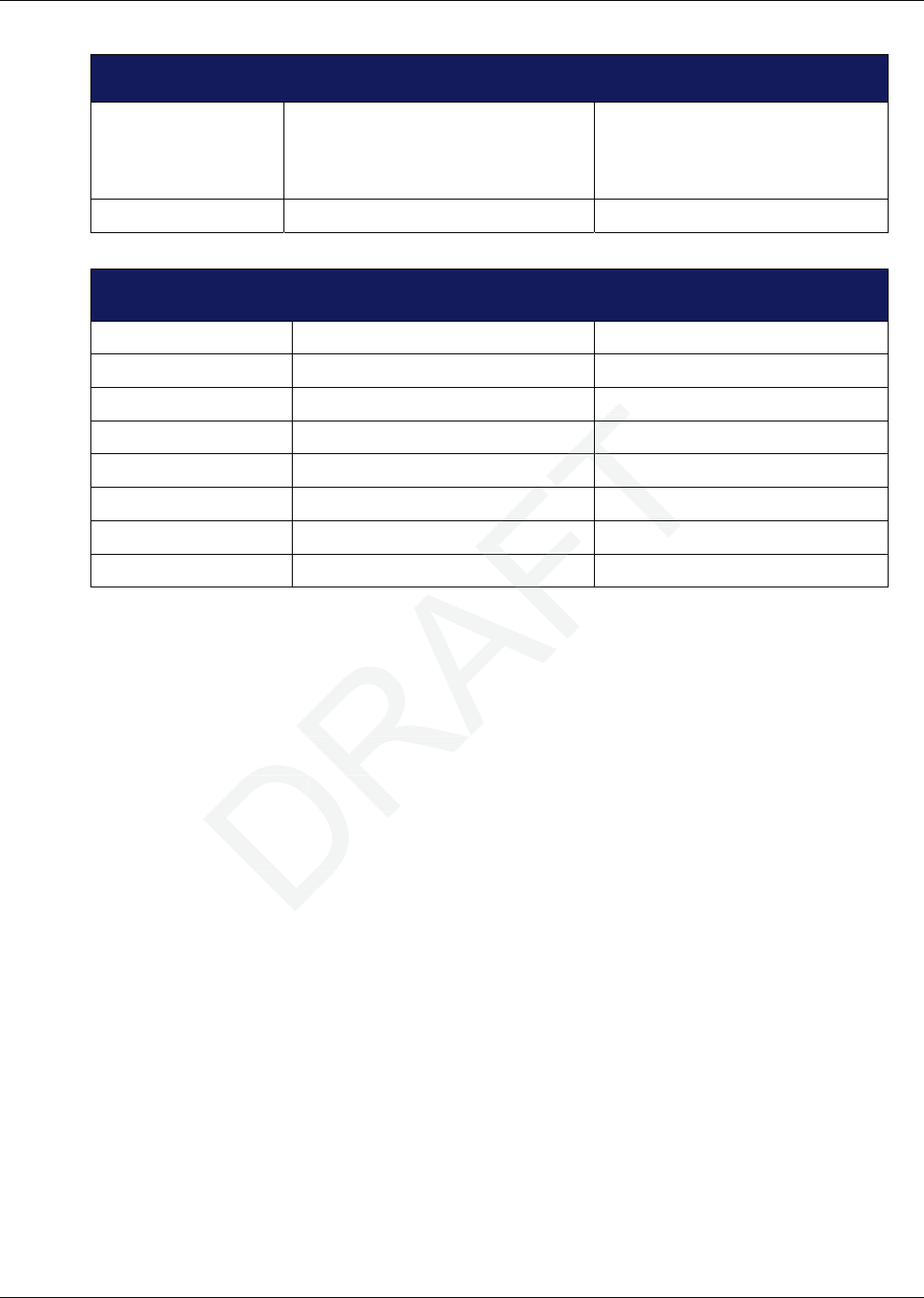
Chapter 9: ARRIS Contacts
Customer Premise Equipment:
Touchstone Products: TGxxx, TMxxx, Touchstone, TTM,
Packet Ace, Cornerstone, HDT,
Incognito, CableModem, eMTA,
Telephone Gateway
techsupport.na@arrisi.com
CableModem: Cable Modem, MTA tac.helpdesk@arrisi.com
International (All Products):
Latin America: Legacy ARRIS Products techsupport.cala@arrisi.com
Latin America: Legacy Motorola Home tac.helpdesk@arrisi.com
Europe: Legacy ARRIS Products techsupport.europe@arrisi.com
Europe: Legacy Motorola Home tac.helpdesk@arrisi.com
Asia: Legacy ARRIS Products techsupport.asia@arrisi.com
Asia: Legacy Motorola Home tac.helpdesk@arrisi.com
Japan: Legacy ARRIS Products techsupport.japan@arrisi.com
Japan: Legacy Motorola Home tac.helpdesk@arrisi.com
Ask ARRIS Customer Portal
The Ask ARRIS Customer Portal enables you to:
Use innovative search technology to deliver fast, relevant, reliable information exactly when you
need it, 24x7
Manage technical support cases for your products, support level, and site location
Access technical documentation and webcasts
To use the portal, you will need to register for the site using your support contract ID and email
address. To access the customer portal:
http://www.arrisi.com/support
Global Knowledge Services and Training
For more information about Global Knowledge Services and the programs we offer, e-mail us at:
training@arrisi.com
Release 24 DRAFT 1.0 November 2014 Touchstone TG2472 Telephony Gateway User Guide 48
echech
tac.helpta
T
T
techsupport
techs
T
T
T
FT
tac.helpdesk@
.helpd
FT
FT
FT
FT
ctscts
techsuppoppo
FT
FT
FT
FT
Home
tac.he
FT
FT
FT
AF
FT
F
F
Portal enables you to:Portal enables you t
rch technology to deliver ch technology to deliver
hnical suphnical sup
port cases for yport cases
echnical documentation
echnical documentation
l, you will need tl, you will need
the customthe custom
comcom

Touchstone TG2472 Telephony Gateway User Guide
Corporate Headquarters
ARRIS · Suwanee · Georgia · 30024 · USA
T: 1-678-473-2000 F: 1-678-473-8470
www.arrisi.com
DRAFT